Learn to make a classic-style Japanese rice omelette called Omurice. It’s a home-cooking staple in Japan adored by people of all ages. In my recipe, I’ll teach you how to make a perfectly creamy and custardy omelette to wrap around savory chicken rice. {Vegetarian-adaptable}
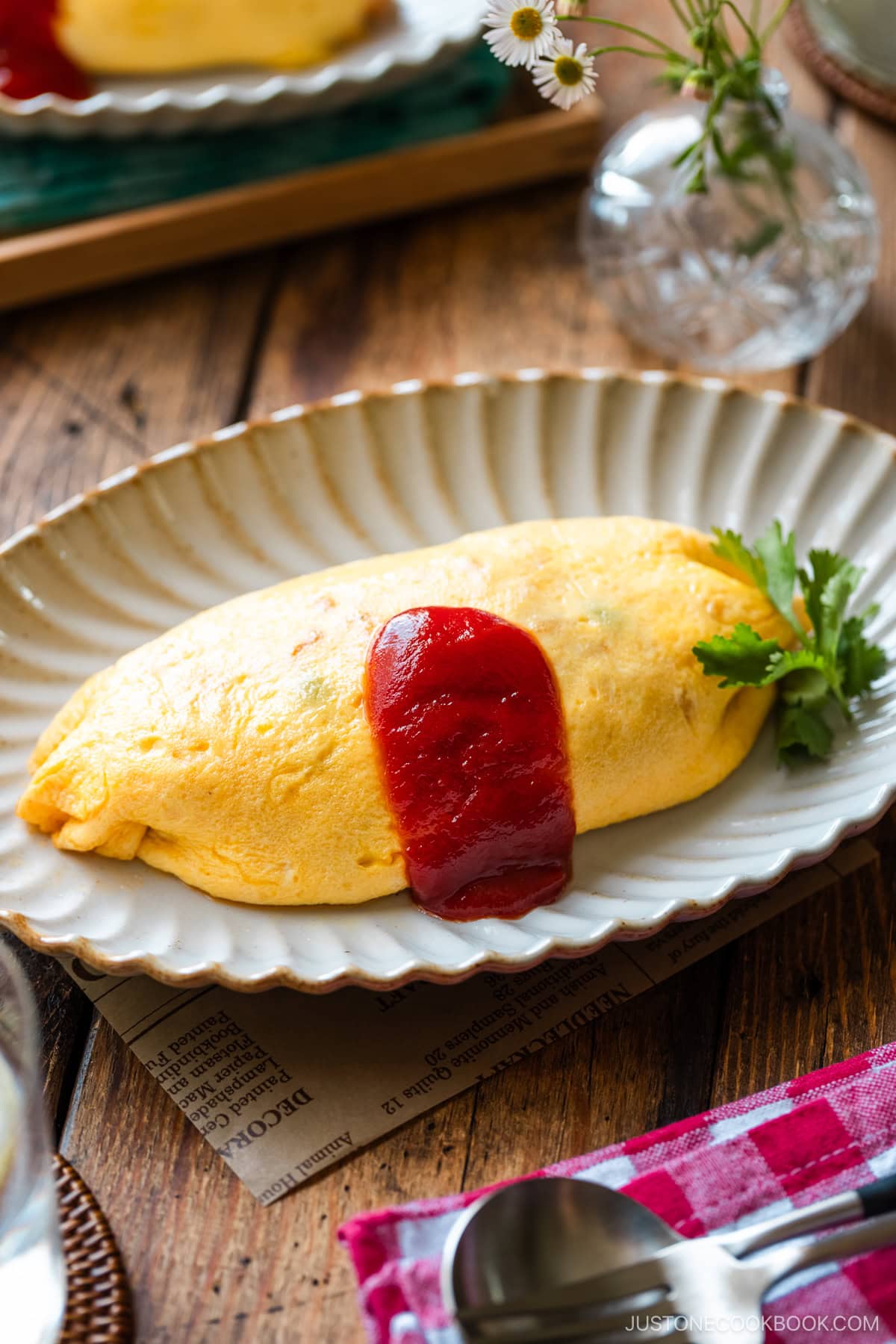
Today, I’m sharing my recipe for the classic-style Japanese rice omelette called omurice (オムライス). My children absolutely loved eating this delicious dish when they were little…and they still do! Young and old alike in Japan feel the same way. Sitting down to a plate of omurice feels like a warm hug; it’s a familiar, everyday meal that brings back childhood memories of mom’s cooking.
All across Japan, you can find this popular yōshoku (Western-style Japanese cuisine) dish in family restaurants, diners, and home kitchens. I’ll teach you my tips and techniques to make restaurant-quality omurice at home that’s tender, full of flavor, and oh-so-comforting!
Table of Contents
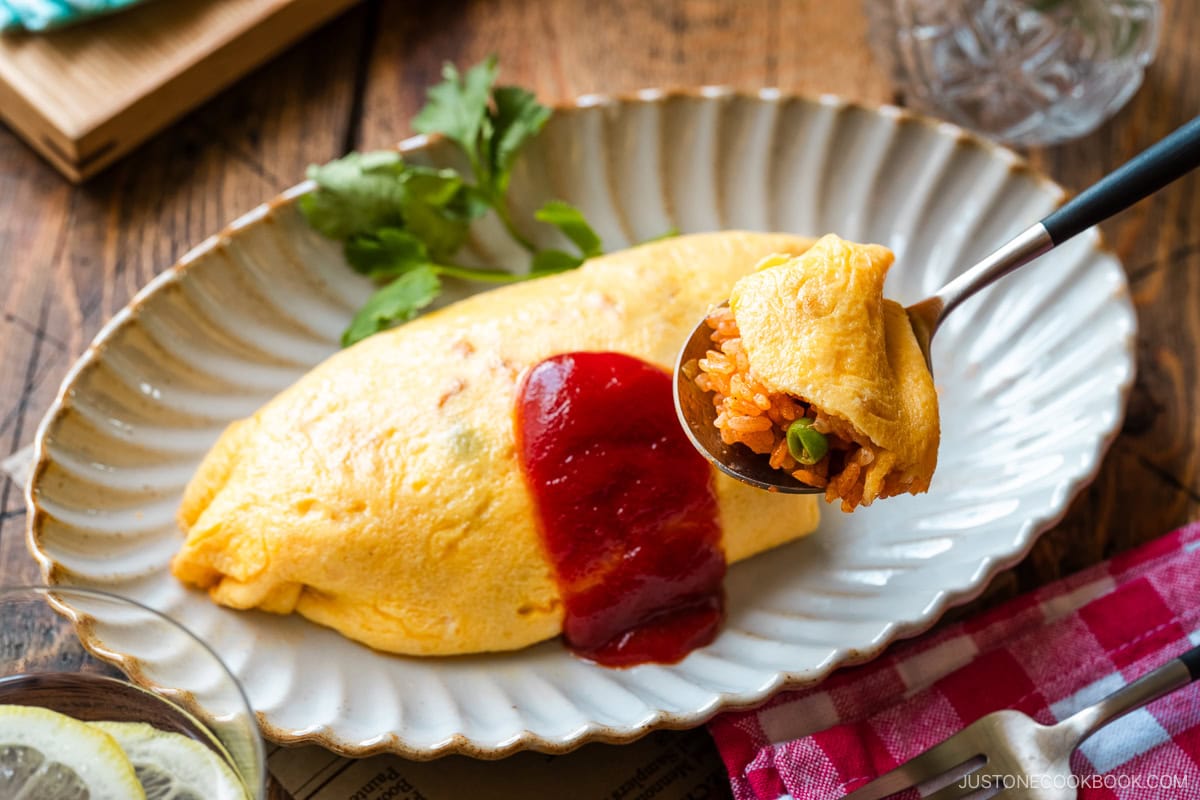
What is Omurice?
Japanese omurice (オムライス) is a thin, soft-cooked omelette wrapped around seasoned Japanese ketchup rice (ケチャップライス) or chicken rice (チキンライス). The name itself is a catchy Japanese loanword that blends “omelette” and “rice.”
This Western-style dish is unique to Japan, as it doesn’t exist in American or European cuisine. Several restaurants in Japan claim to have created omurice in the early 1900s. However, it was in 1925 that a chef in Osaka at a Western-style diner called Hokkyokusei created a dish very similar to the omurice that we know and love today.
Why You’ll Love This Recipe
- Creamy texture — Omurice is all about the soft-scrambled and tender omelette. I’ll teach you how to fry the eggs evenly so they’re creamy and custardy, just like a classic French omelette.
- Quick to make — You can cook it from start to finish in less than 30 minutes.
- Affordable and practical — It uses common staple ingredients from your fridge, freezer, and pantry.
- Kid-friendly — Kids love the savory ketchup flavor of the rice and the soft omelette texture.
- Flexible — Substitute any protein and vegetables from your fridge in the seasoned rice (see below for ideas).
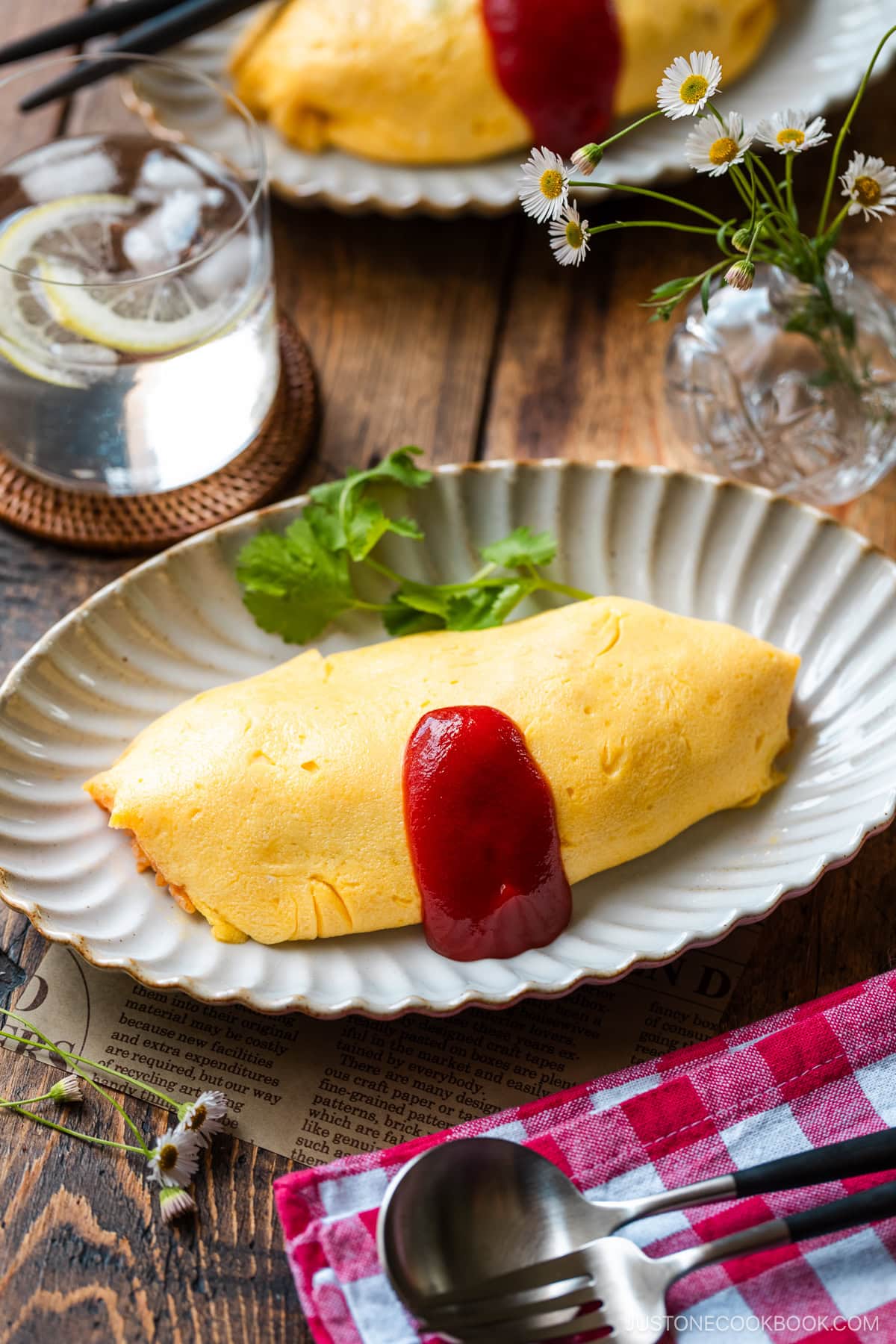
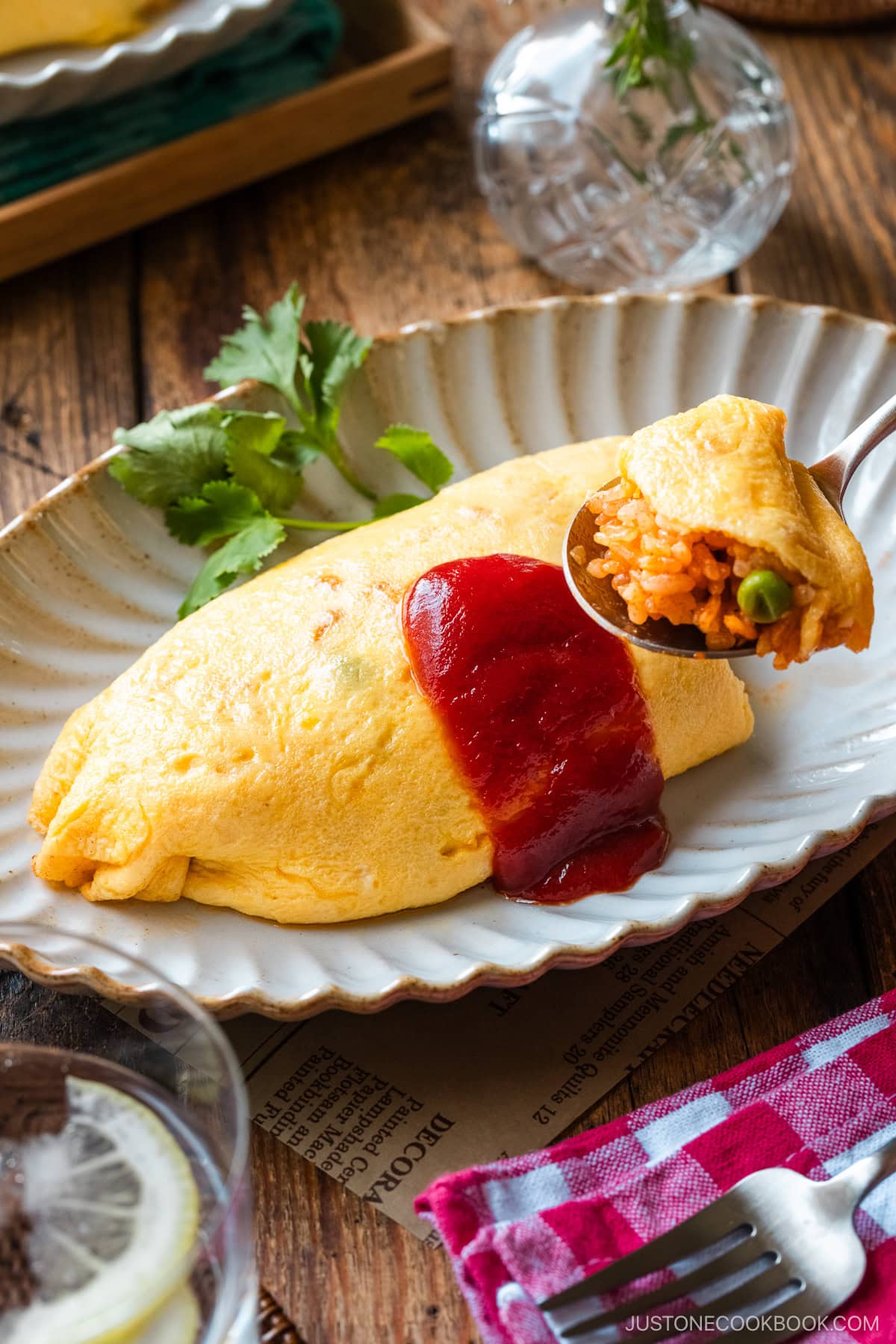
Ingredients for Omurice
You‘ll need eggs, rice, and ketchup to make the classic version, but I‘ll suggest some creative substitutions later.
- Large eggs
- Cooked Japanese short-grain rice — warm; you can reheat frozen rice if you have it
- Chicken thigh — stays juicier and more flavorful compared to chicken breast
- Onion
- Green peas
- Ketchup — the classic seasoning for chicken rice (ketchup rice); I highly recommend KAGOME brand Japanese ketchup
- Worcestershire sauce — adds complexity to the rice; you can substitute it with tonkatsu sauce or soy sauce
- Butter — adds a rich and creamy texture to the rice and omelette
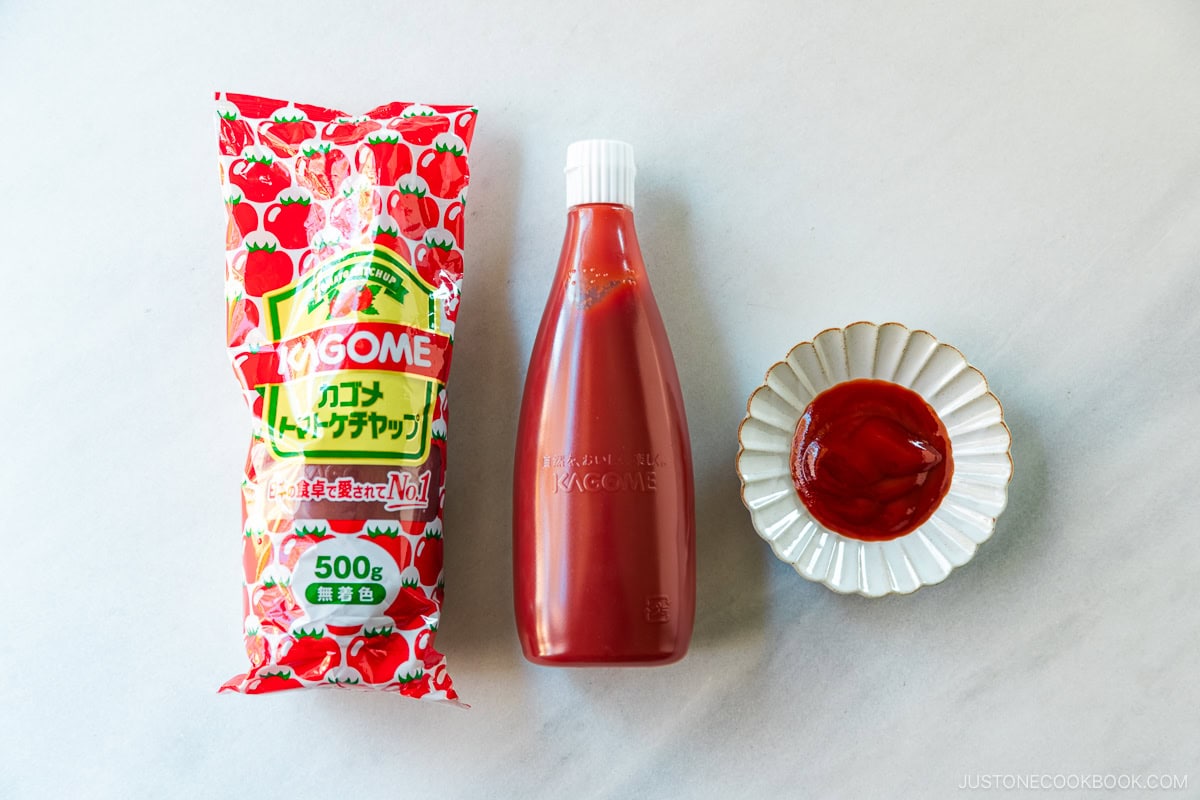
Substitution Tips and Variations
- Swap out the protein in the chicken rice with bacon, chashu pork, ham, shrimp, baked or fried tofu, and edamame—or skip it all together.
- While ketchup-flavored rice is classic, you can change up the seasoning any way you like. Try using soy sauce, simple salt and pepper, curry powder, or garlic.
- Instead of a pan, you can use your electric rice cooker to make my Rice Cooker Chicken Rice or seasoned mixed rice in the style of takikomi gohan with great results.
- Try a different sauce. Japanese love demi-glace omurice topped with demi-glace sauce, hambagu omurice with Japanese hamburger steak and sauce, hayashi omurice with hayashi rice sauce, curry omurice using Japanese curry, and cream omurice with a bechamel sauce. You could even drizzle oyster sauce on top.
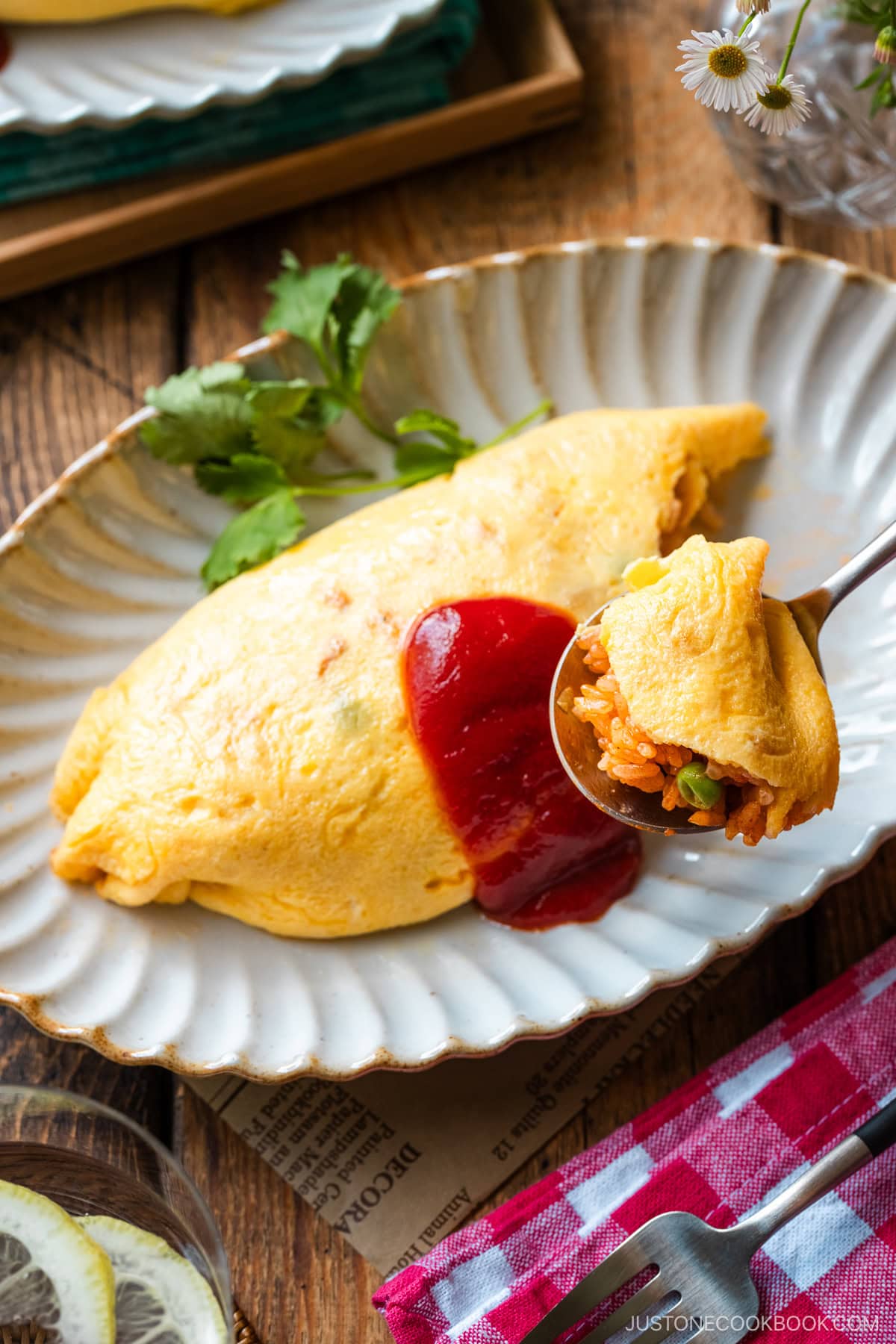
How to Make the Best Omurice
Cooking the egg goes very quickly. Be sure to follow my techniques in the next section for a creamy and soft-scrambled texture.
- Cook the chicken rice: Stir-fry the chicken and onion, then season them with ketchup. Let the excess moisture evaporate first, then add the steamed rice. Toss to combine and set aside. Alternatively, you can make my Rice Cooker Chicken Rice ahead of time and freeze individual portions so you can start making an omelette right away!
- Cook the omelette: Beat the eggs and salt and strain them through a fine-mesh strainer. Melt the butter in a frying pan and add the egg mixture. Stir the eggs constantly with a pair of chopsticks while you shake the pan to make soft, small curds.
- Assemble the omurice: When the eggs are half-cooked, place the chicken rice in the center of the omelette. Move the pan to a wet cloth to cool it. Wrap both sides of the omelette around the rice in an oval shape. Invert the omurice onto a plate and fix the shape with a paper towel. Pour the sauce or drizzle a zigzag pattern of ketchup onto the omurice.
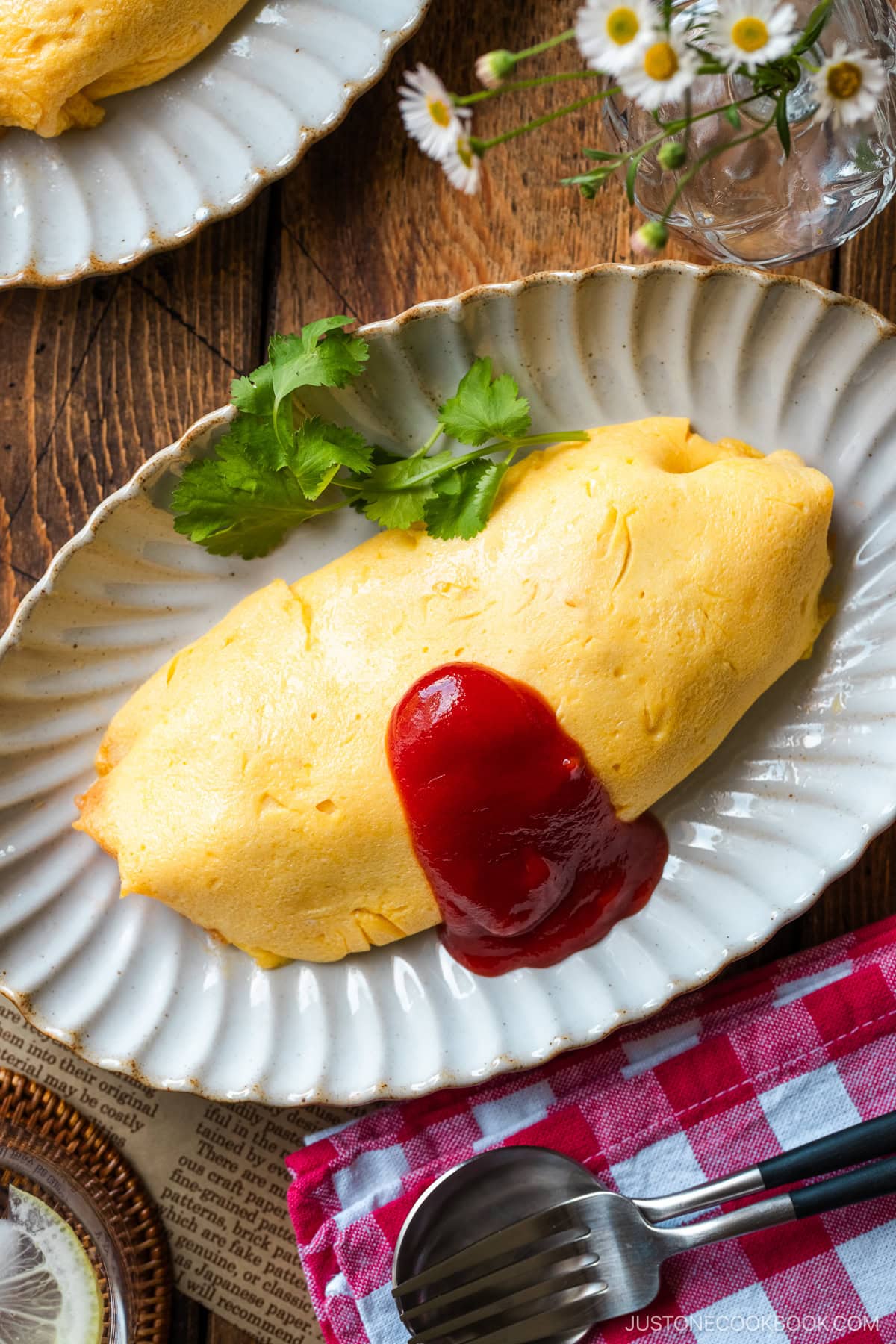
Recipe Tips and Techniques
- Use a small-size, nonstick skillet. I recommend an 8-inch (20 cm) nonstick frying pan. If you use a large pan, the egg will spread thin and you’re more likely to crack or tear the omelette. It’s also extremely hard to fold and flip when making a large omurice. I’ve tried using my favorite carbon steel pan, but it was very challenging to make an omelette with a smooth surface.
- Strain the beaten eggs. For a silky-smooth omelette, use a fine-mesh strainer to remove the two stringy bands on the yolk called the chalaza. This helps to give the cooked eggs a uniform texture.
- Shape the rice before you add it to the omelette using the side of a small bowl and a spatula. If you try to shape it into a half moon after adding it to the pan, you might tear the omelette. Proportioning also helps keep the omurice the same size. Gently spread the rice to the sides.
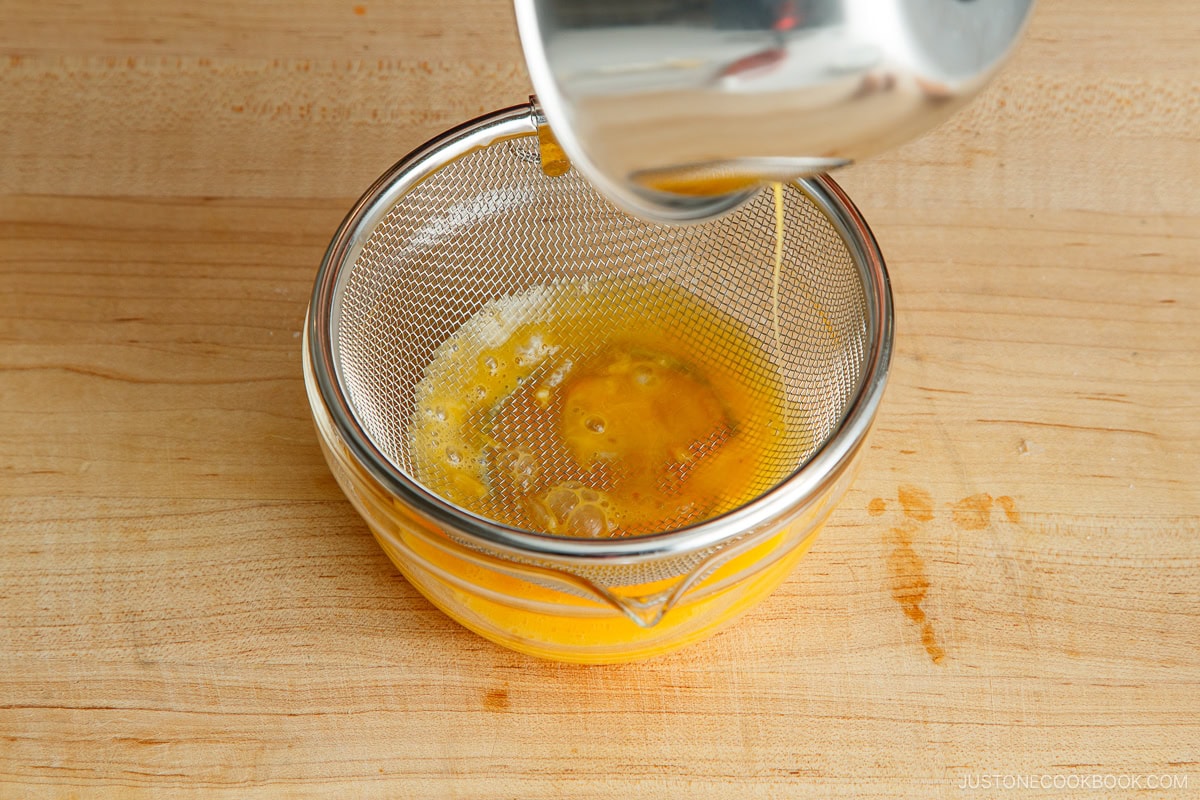
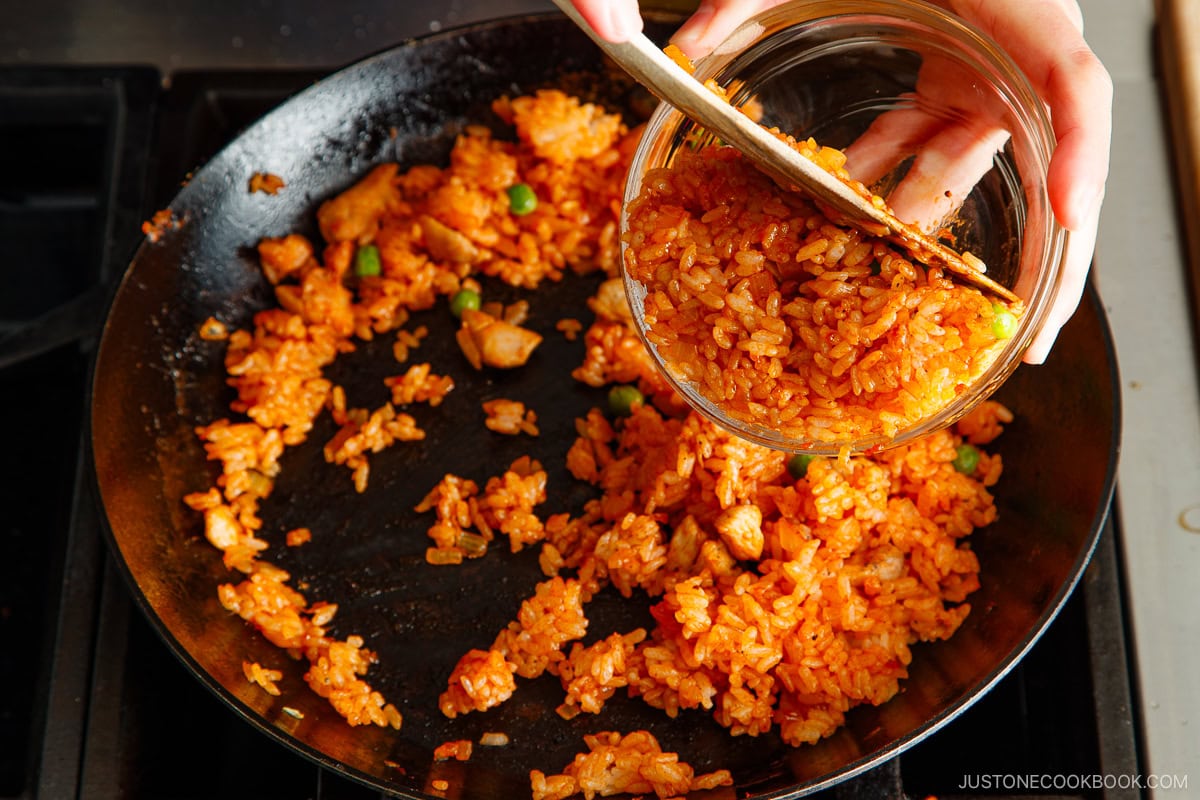
- Stir the eggs quickly in a spiral motion with chopsticks while you shake the pan. Keep the eggs moving so you end up with soft, small curds and an even exterior surface. I found that chopsticks can create really nice small curds better than a silicone spatula.
- Stop stirring when the eggs are half-cooked. You want to see a smooth omelette surface, not the chopsticks’ stirring marks. Therefore, stop stirring while the eggs are still rather runny. Tilt the frying pan to spread out the remaining uncooked egg mixture. The egg curds should look creamy, soft-scrambled, and custardy at this stage. You don’t want to overcook them, as they’ll continue to cook a little with the residual heat. Make sure to level the egg curds.
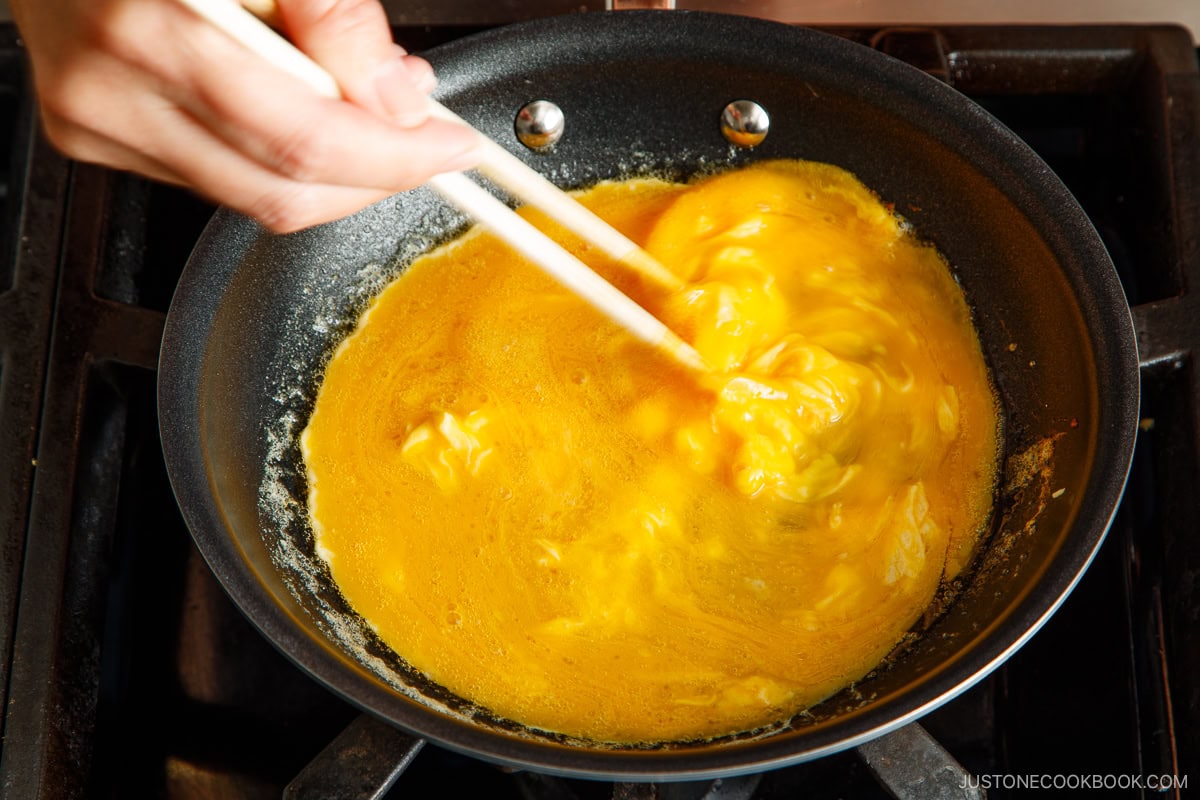
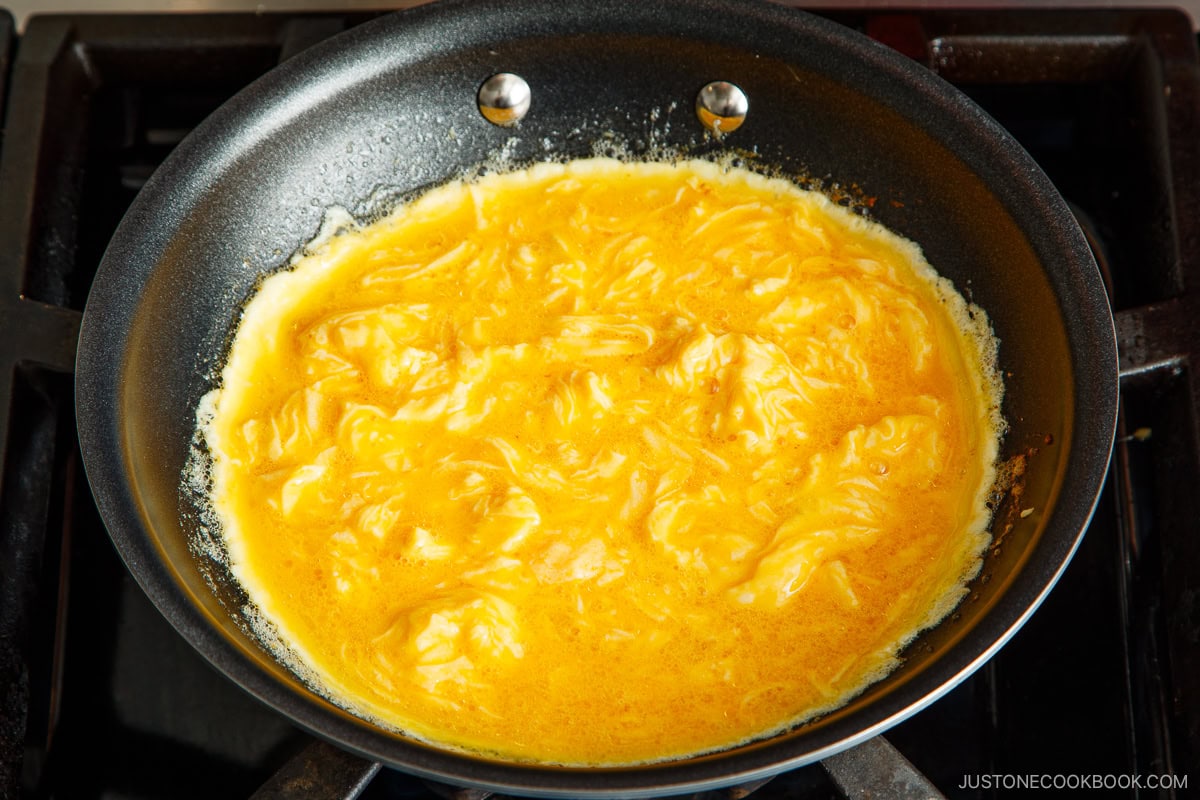
- When the eggs are half-cooked, place the chicken rice in the center of the omelette. Spread it out to the sides a little. Create a rough football shape without moving and touching the omelette.
- Move the pan to a wet folded cloth to cool it. This prevents the omelette from browning, ensuring that your omurice is an even pale yellow color. Then, slide the omelette to the far edge from the handle and wrap the rice with omelette from both sides.
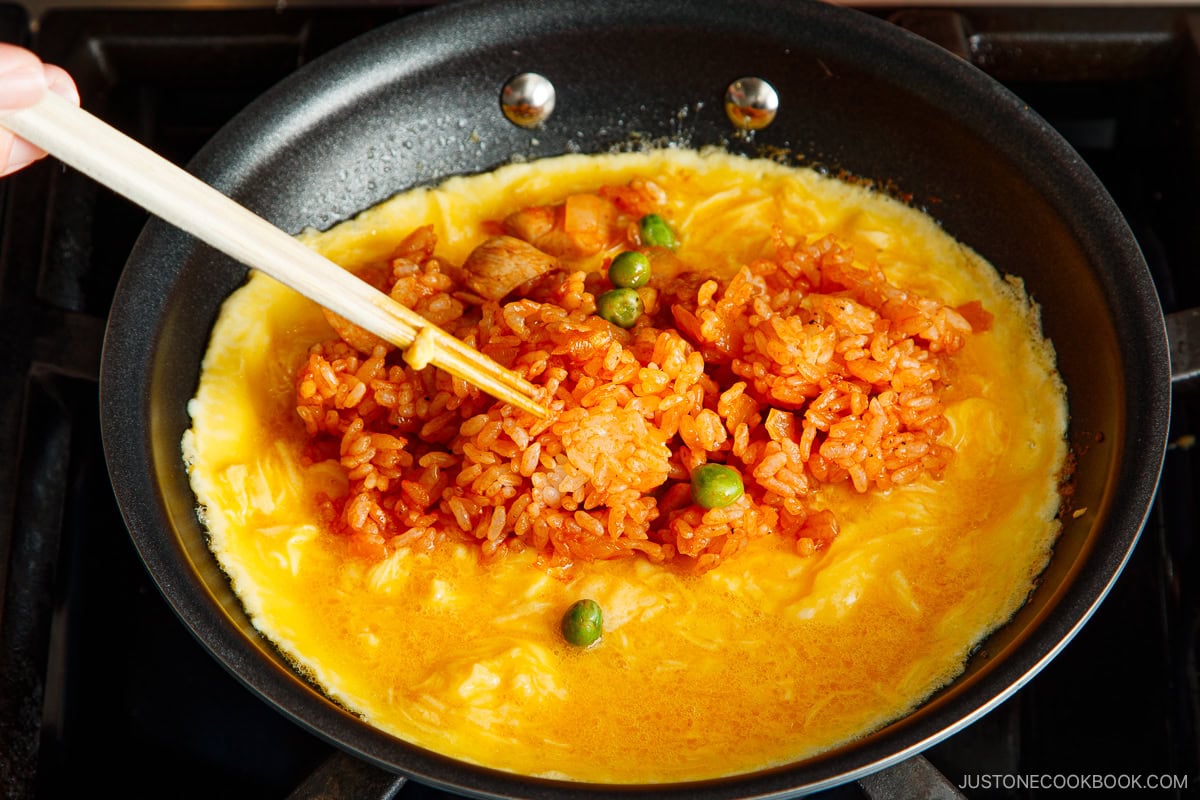
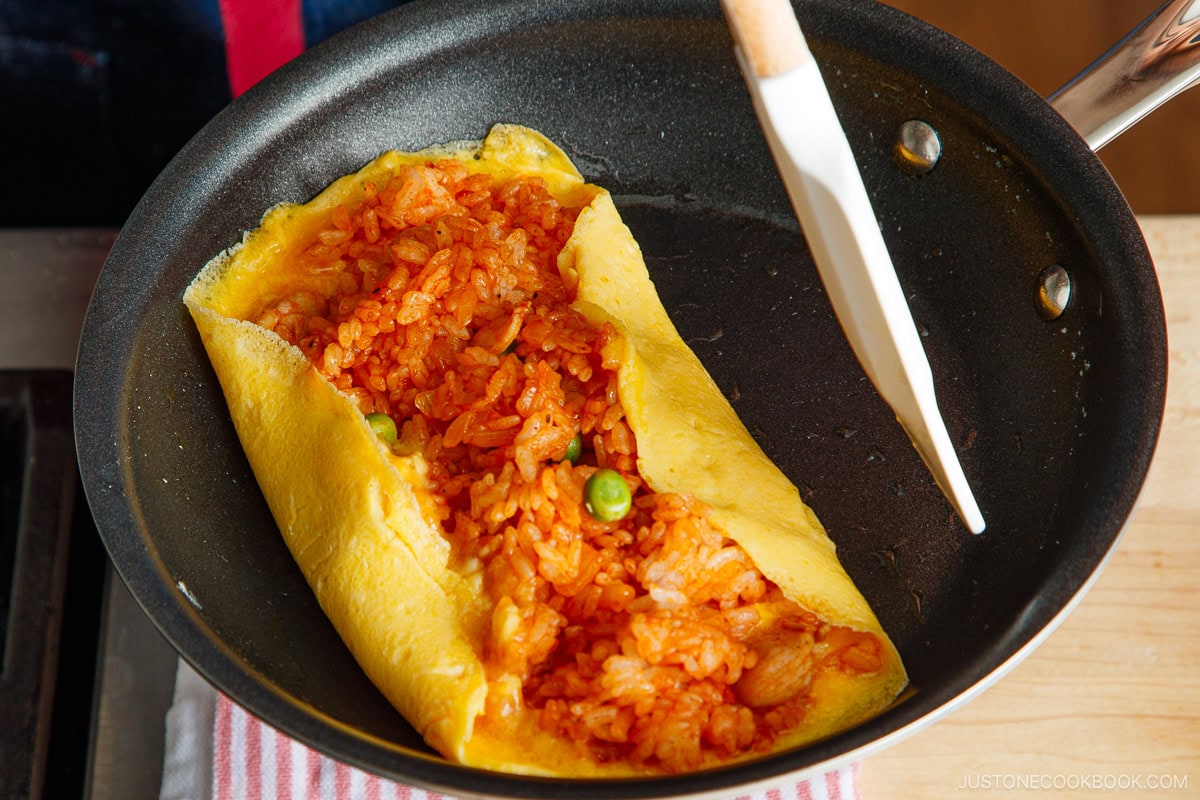
- Tilt a plate and hold the frying pan upside down at an angle to flip the omurice onto the plate.
- Use a paper towel to shape the omurice. Once you invert it onto a plate, place a paper towel on top and gently mold it with your hands into the shape of a rugby ball.
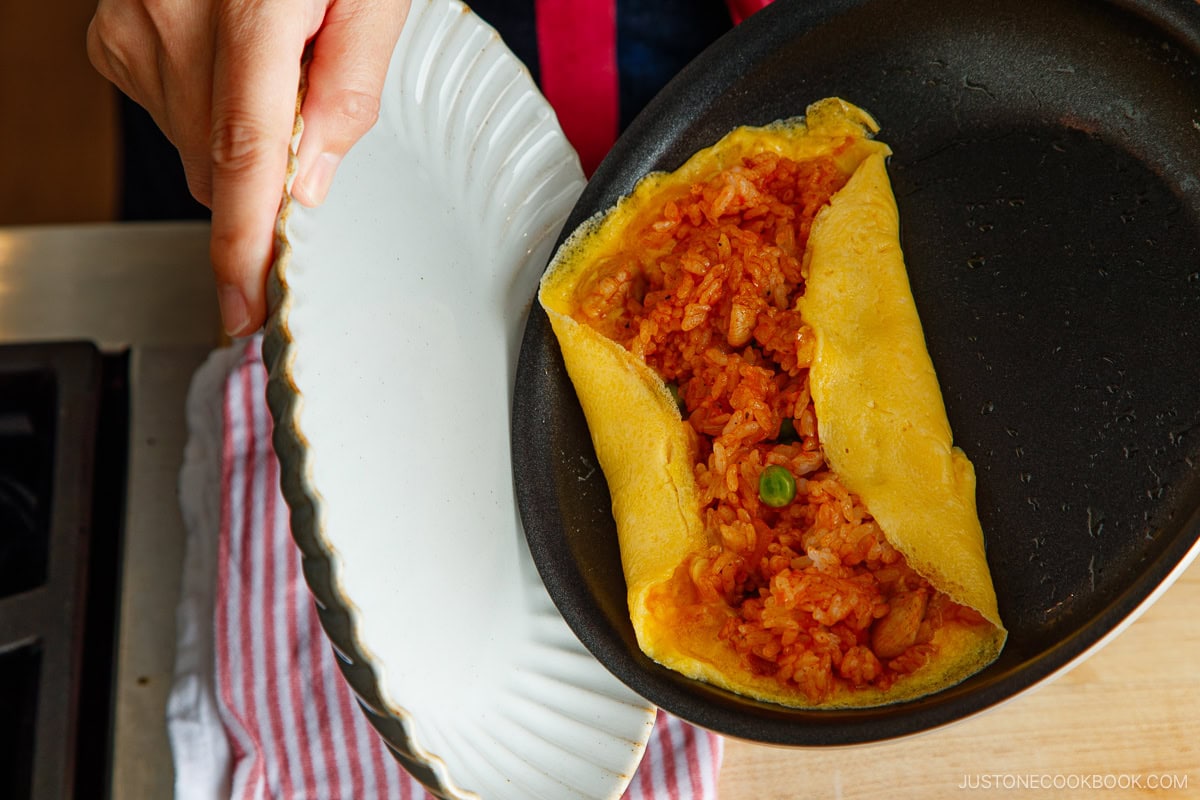
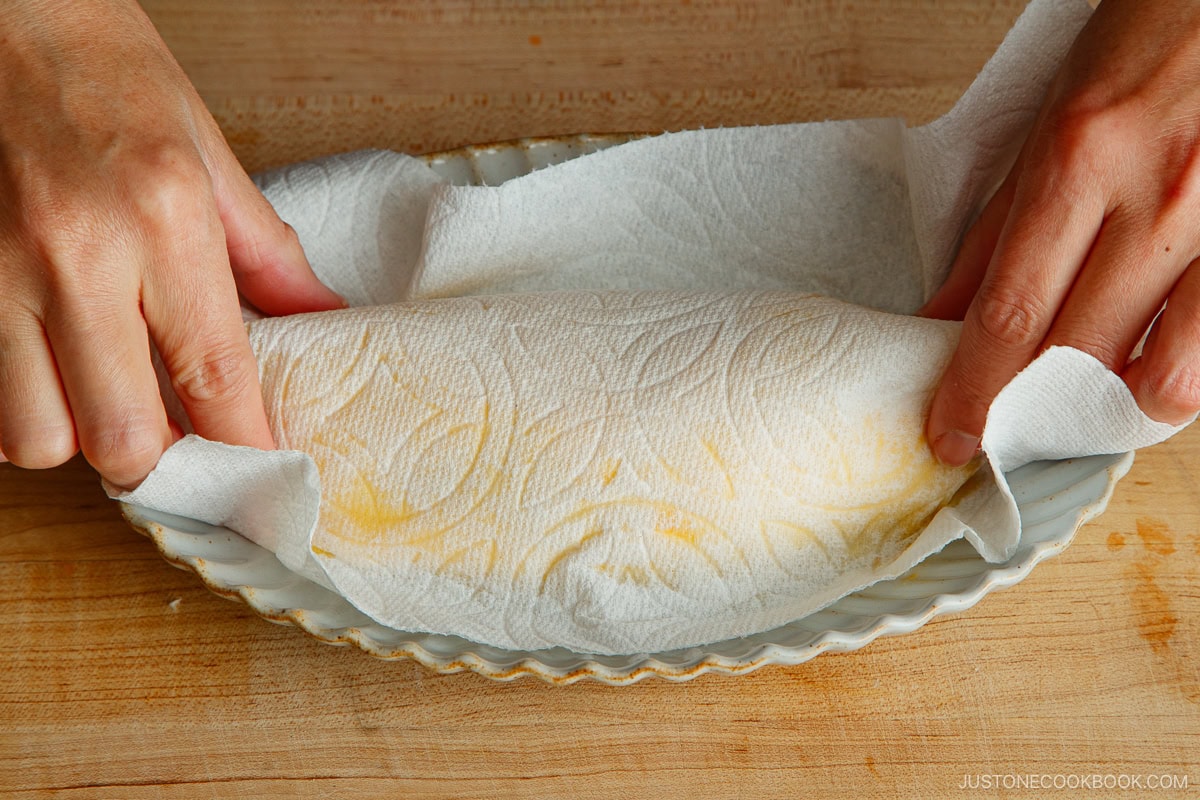
Do You Need an Omurice Pan?
An omurice pan is a small, deep frying pan that’s specifically designed to cook Japanese omelets. They’re meant to help with shaping your omurice and will usually have a nonstick surface.
While they can be helpful with this recipe, I like to use my All-Clad D3 8-inch Fry Pan, which is made from tri-ply stainless steel and bonded for fast, even heating. It’s on the pricier side at around $130, but I think it’s definitely worth it since it’s compatible with any stovetop, has a top-quality nonstick coating, and is completely warp-resistant.
Making the Chicken Rice in a Rice Cooker
You can make the chicken rice in an electric rice cooker. The recipe is coming soon!
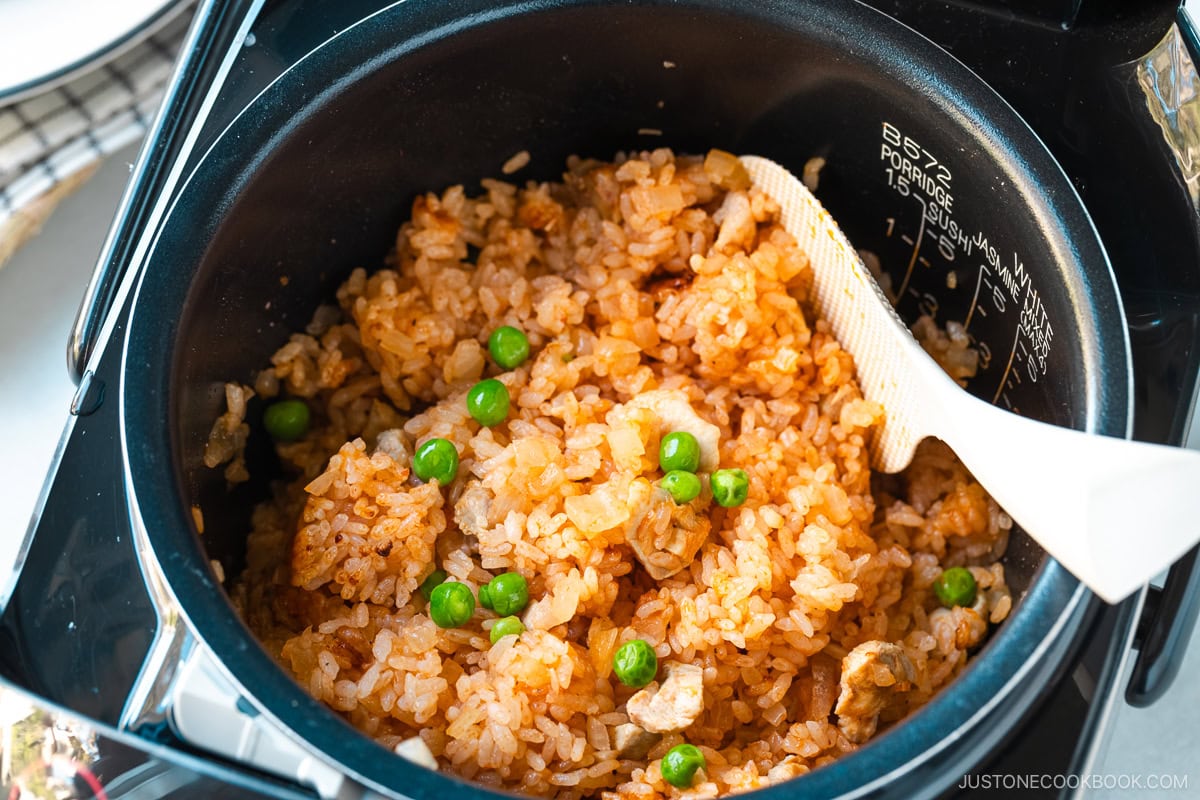
Feel free to make this rice cooker chicken rice ahead and freeze individual portions, so you can make omurice whenever you want to eat it.
How to Store
- To Store: You can keep the leftovers in an airtight container and store in the refrigerator for up to 3 days or in the freezer for a month.
- To Reheat: Microwave until warm.
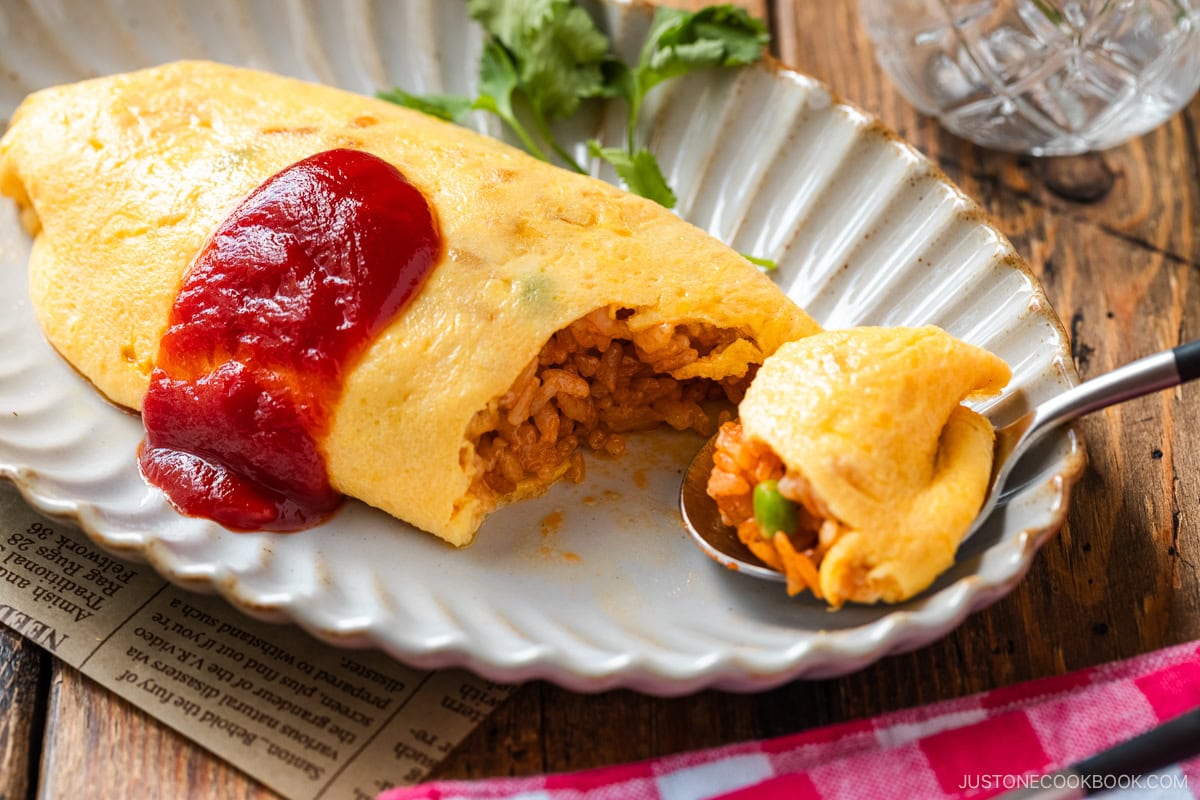
What to Serve with Omurice
- Soup – Bacon and Asparagus Miso Soup or Corn Potage
- Salad – Apple Walnut Salad or Japanese Kani (Crab) Salad
- Sides – Green Beans with Yuzu Vinaigrette or Miso Butter Mushrooms
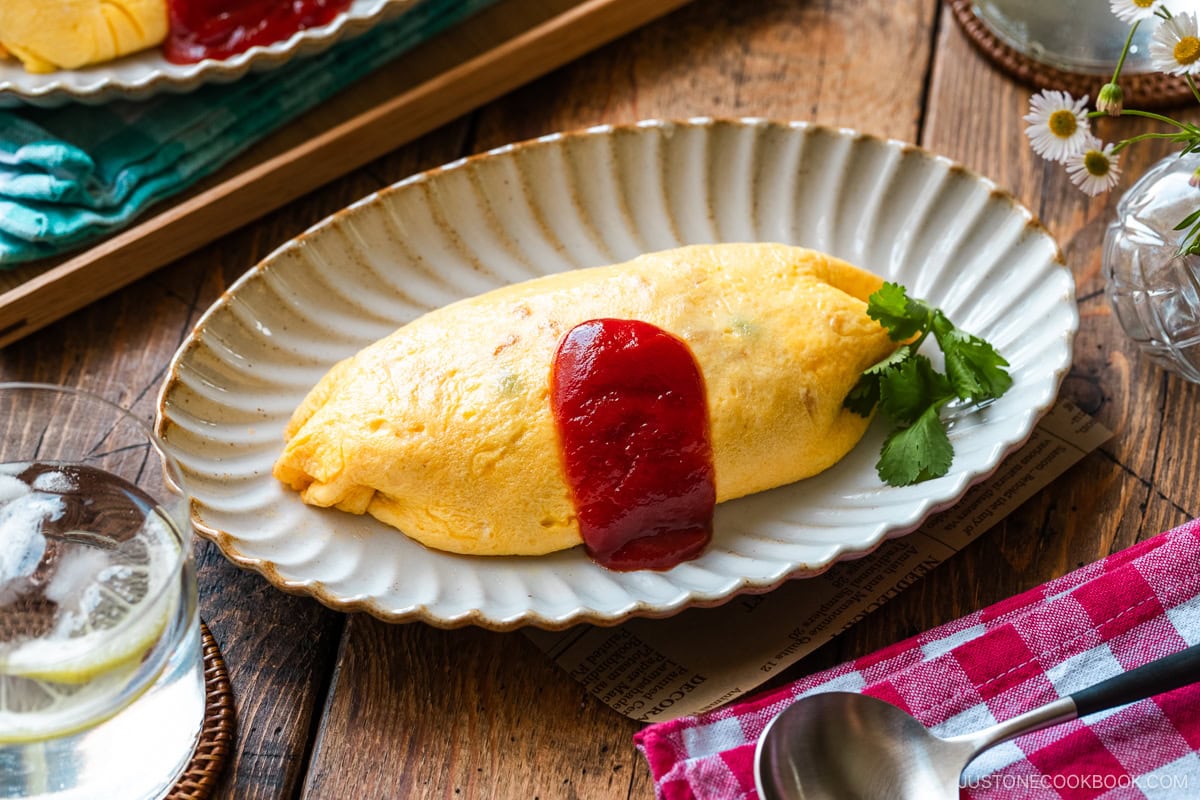
Wish to learn more about Japanese cooking? Sign up for our free newsletter to receive cooking tips & recipe updates! And stay in touch with me on Facebook, Pinterest, YouTube, and Instagram.

Omurice (Japanese Omelette Rice)
Video
Ingredients
For the Chicken Rice
- ¼ onion (4 oz, 113 g)
- 3 oz boneless, skinless chicken thigh
- 1 Tbsp unsalted butter
- 1 Tbsp green peas (cooked)
- ½ tsp Diamond Crystal kosher salt (divided)
- freshly ground black pepper
- 2 servings cooked Japanese short-grain rice (1¾ cups, 330 g; warm)
- 5 Tbsp ketchup (plus more for garnish; for an authentic taste, I highly recommend KAGOME brand Japanese ketchup)
- 1 tsp Worcestershire sauce
For the Omelettes
- 4 large eggs (50 g each w/o shell) (divided)
- ½ tsp Diamond Crystal kosher salt (divided)
- 2 Tbsp unsalted butter (divided)
Instructions
- Before You Start: For the chicken rice, you can use reheated frozen rice if you have it. See how to cook Japanese rice with a rice cooker, pot over the stove, Instant Pot, or donabe.
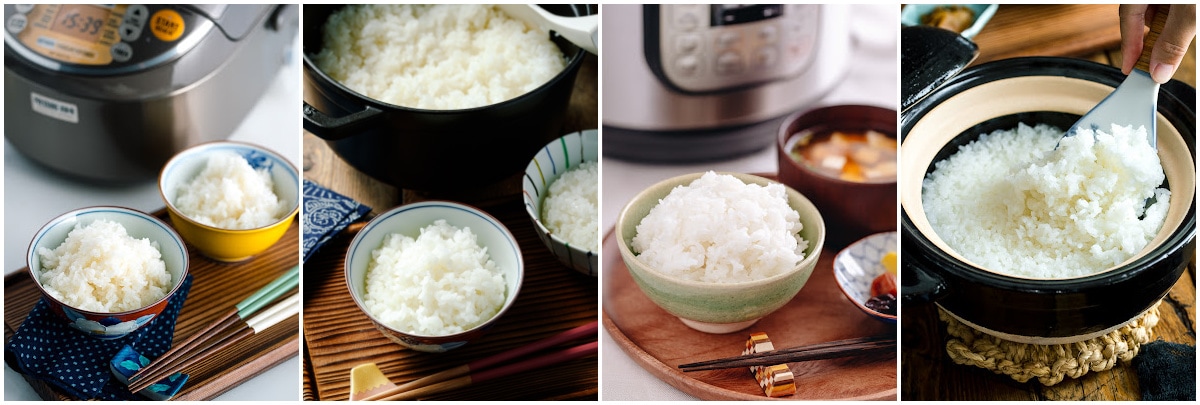
- Gather all the ingredients.
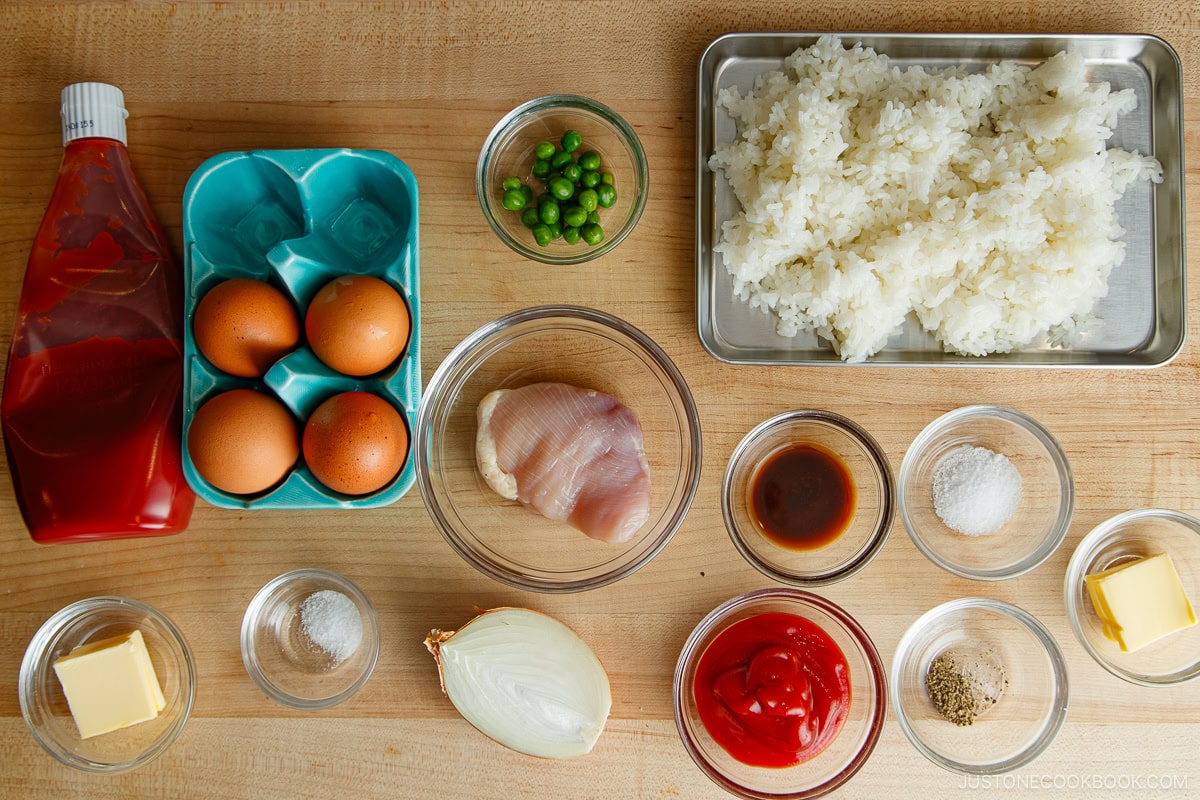
To Make the Chicken Rice
- Lay ¼ onion flat side down on the cutting board. With the knife edge toward the root end, make ⅛-inch horizontal slices to within ½ inch of the root end, keeping the root intact. Then, make ⅛-inch vertical slices, again keeping the root intact.
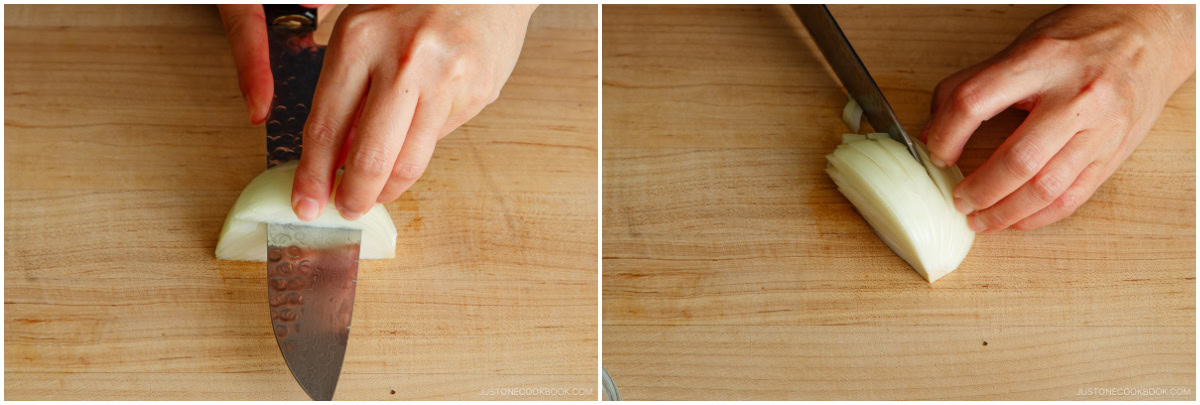
- Mince finely into ⅛-inch (3-mm) pieces. If you need to chop the onion pieces finer, run your knife through them using a rocking motion. Hold down the tip of the knife; otherwise, the onions will go flying around the room.
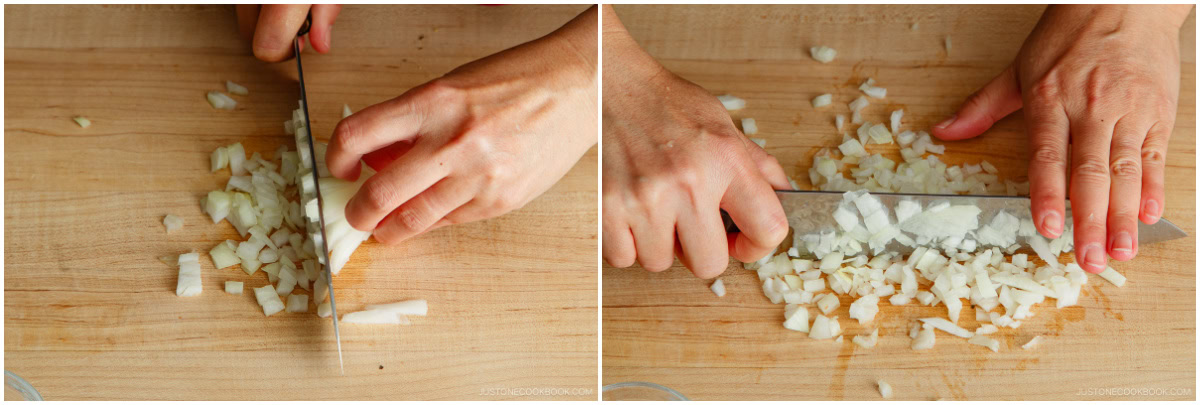
- Angle your knife back and diagonally, and then slice 3 oz boneless, skinless chicken thigh along the grain into strips about ½ inch (1.5 cm) wide. Next, angle your knife again and slice the chicken strips against the grain into pieces about ½ inch (1.5 cm) square. This sogigiri cutting technique gives the chicken pieces equal thickness and creates more surface area for fast cooking and better absorption of the flavors.
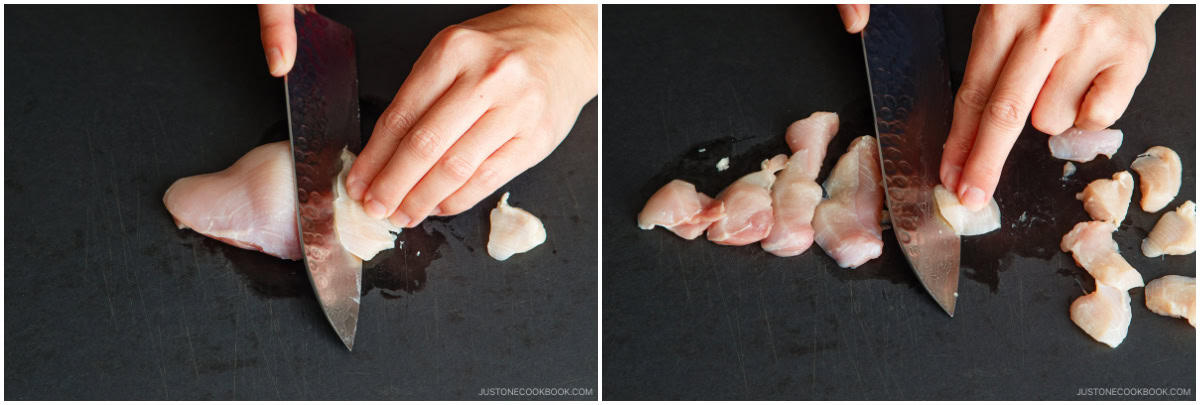
- Heat 1 Tbsp unsalted butter in a large frying pan over medium heat and add the minced onion.
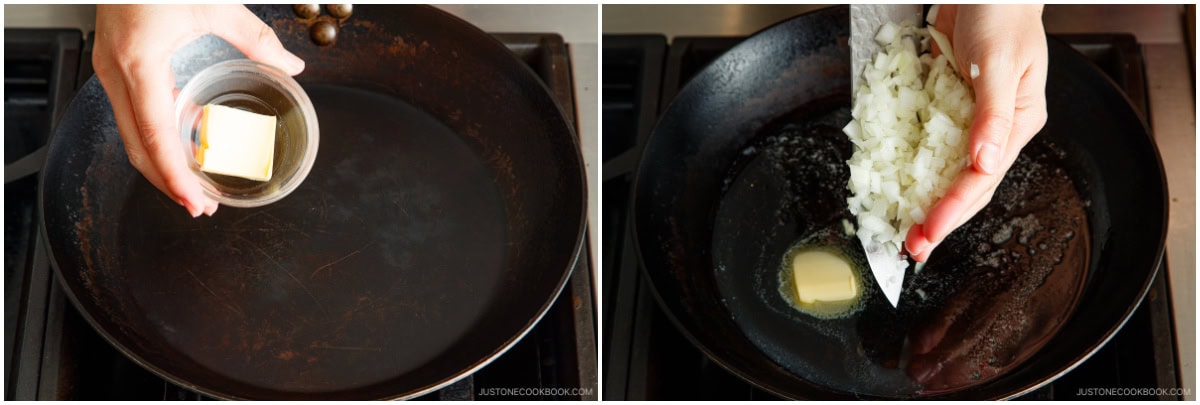
- Sauté the onions until tender.
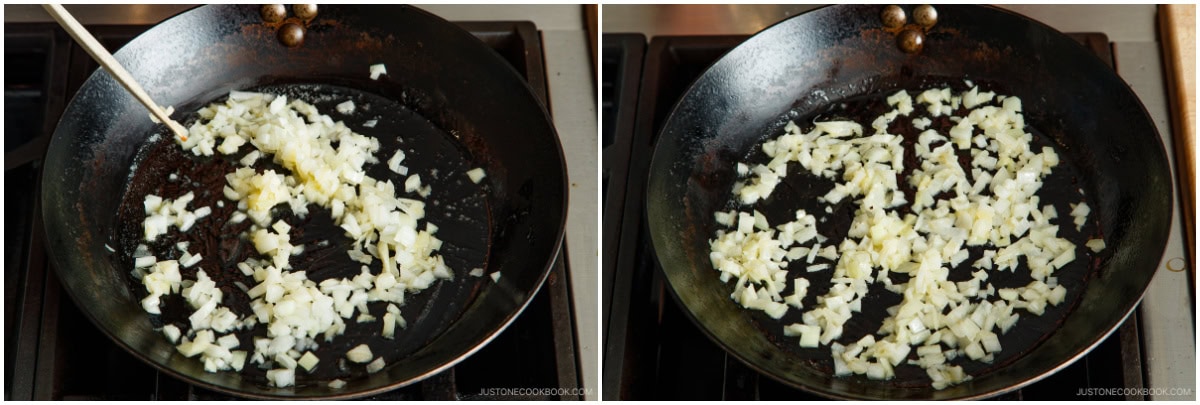
- When the onions are tender, add the chicken and season it with half of the Diamond Crystal kosher salt and freshly ground black pepper.
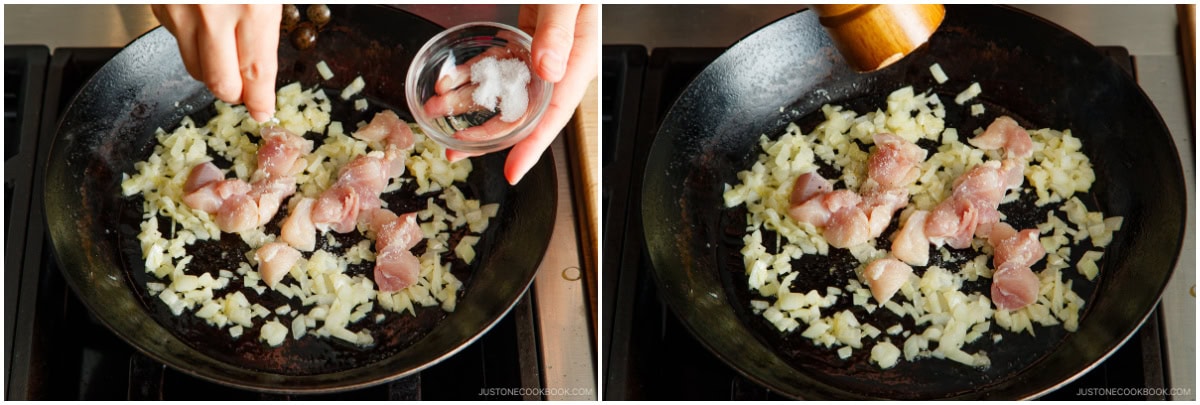
- Cook the chicken until it‘s no longer pink.
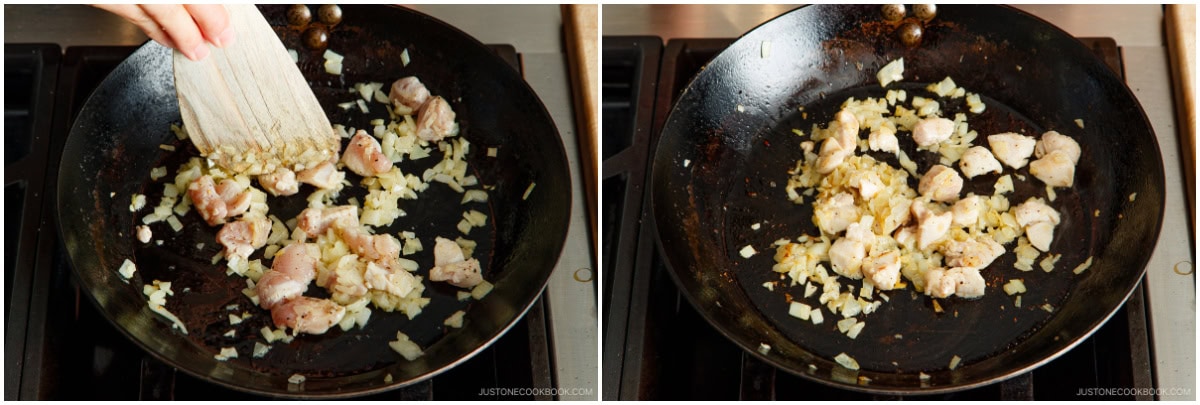
- Reduce the stove‘s heat a little and add 5 Tbsp ketchup and 1 tsp Worcestershire sauce and stir to combine. Let the excess moisture evaporate so the rice will not become mushy.
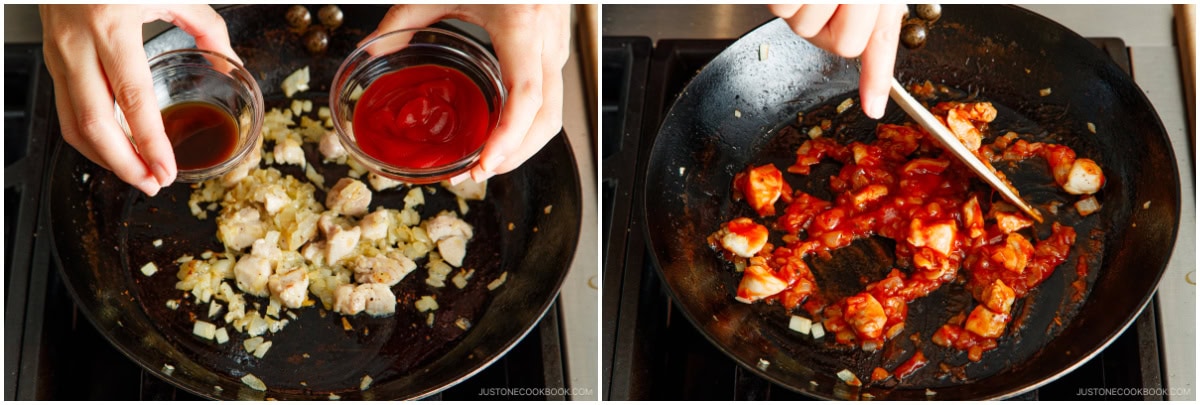
- Add 2 servings cooked Japanese short-grain rice. Use a cutting motion with your spatula to break the clumps into small pieces.
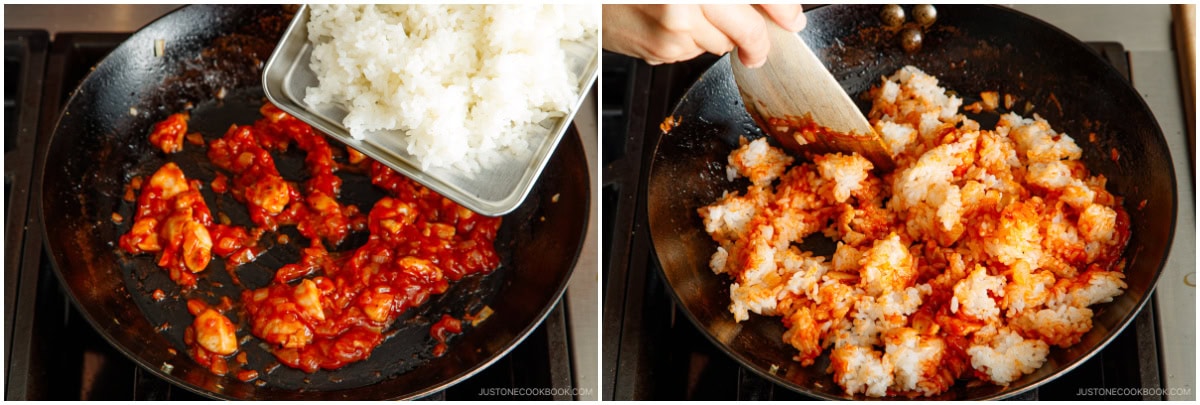
- Season with remaining half of the Diamond Crystal kosher salt and freshly ground black pepper.
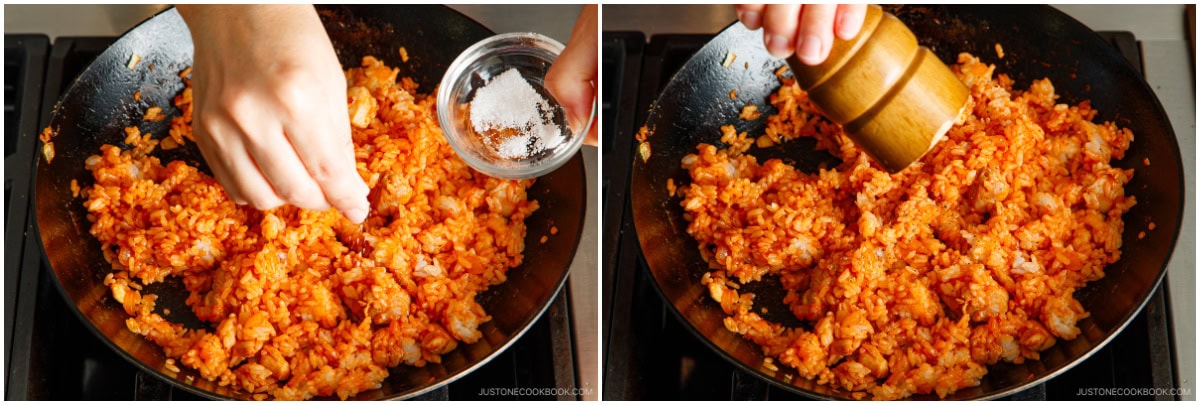
- Add 1 Tbsp green peas and toss to combine. Remove from the heat. Divide the chicken rice into 3 portions; use 2 portions today and freeze the extra portion to use next time. Set aside. You will shape the rice before you add it to the omelette using the side of a small bowl and spatula.
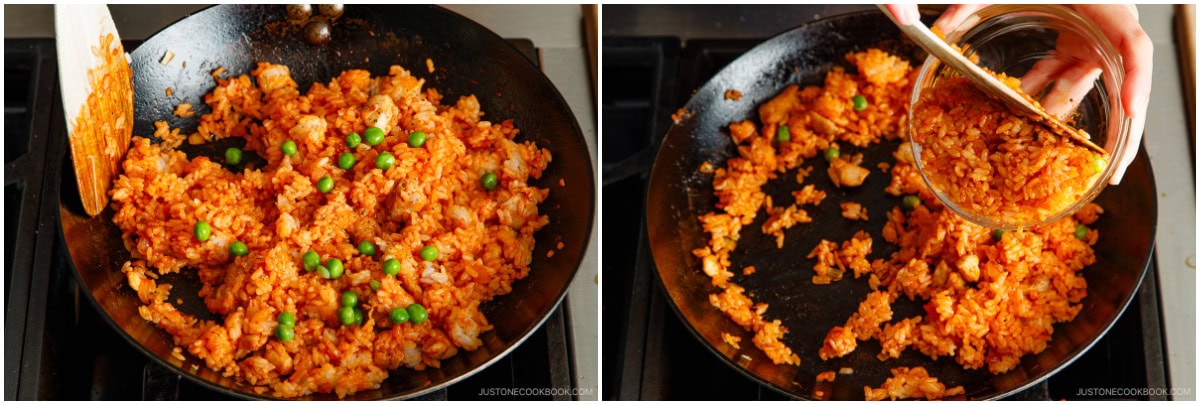
To Make the Omurice
- We‘ll make the omurice one at a time. Crack 2 large eggs in a small bowl. Using chopsticks, beat the eggs in a zigzag motion while you keep the chopsticks' tips touching the bowl's bottom. Cut the egg whites instead of whisking.
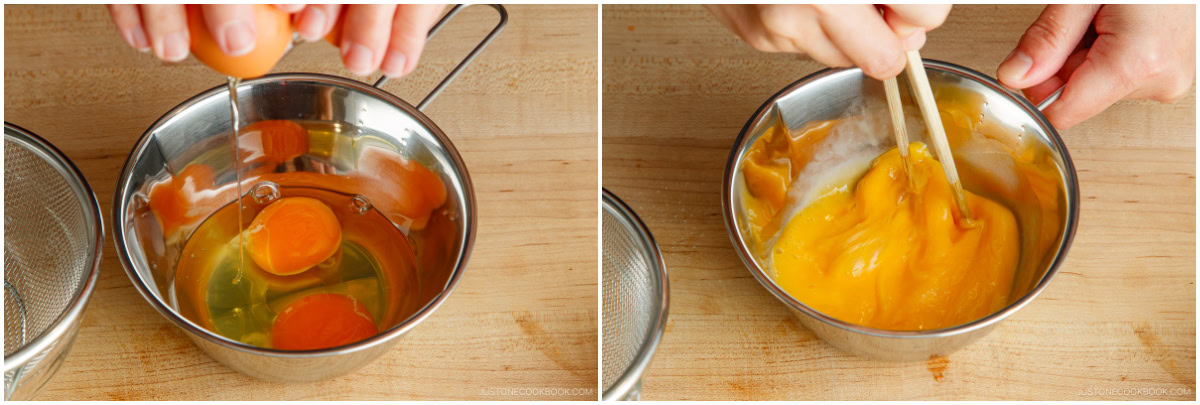
- Add ¼ tsp Diamond Crystal kosher salt. Then, strain the beaten eggs through a fine-mesh strainer. This removes the stringy bands on the yolks called the chalaza to give the cooked eggs a uniform and silky-smooth texture.
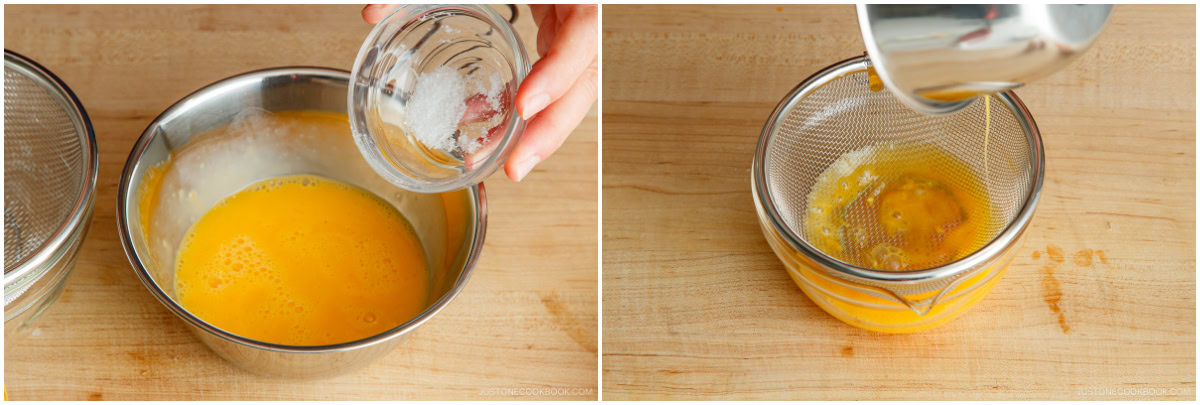
- Heat 1 Tbsp unsalted butter in the pan over medium heat. Distribute the butter to make sure the surface of the pan is coated well.
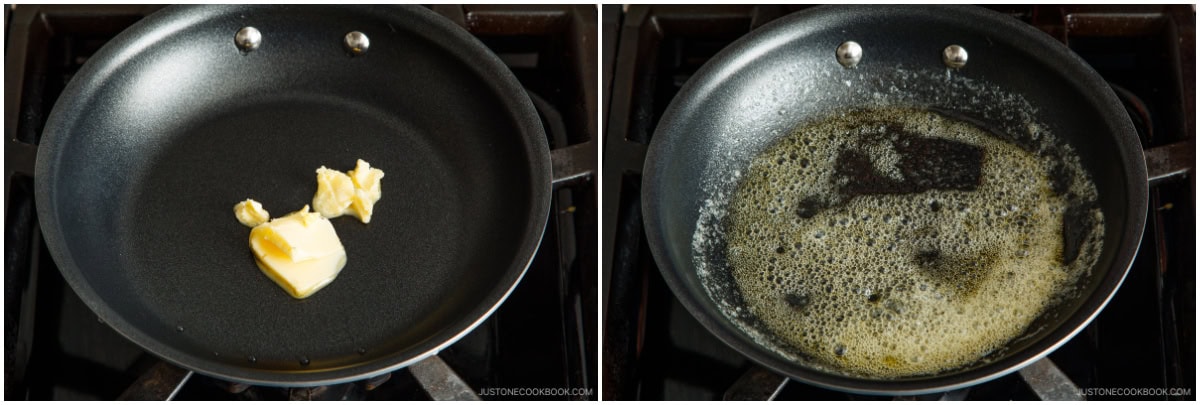
- Check if the pan is hot by adding a drop of the egg mixture into the pan with a chopstick. If it sizzles, then pour in the egg mixture.
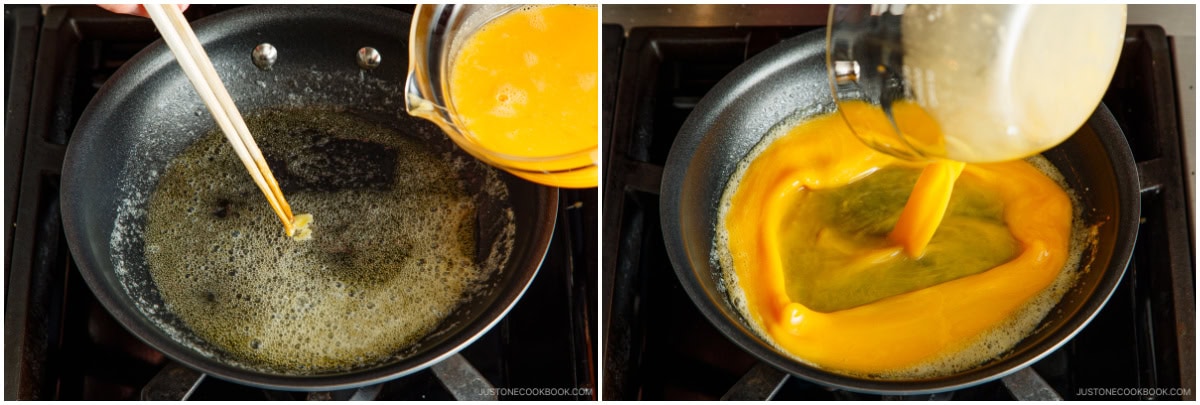
- Stir the eggs quickly in a spiral motion with chopsticks while you shake the pan. Keep the eggs moving so you end up with soft, small curds and an even exterior surface. I found that chopsticks can create really nice small curds better than a silicone spatula.
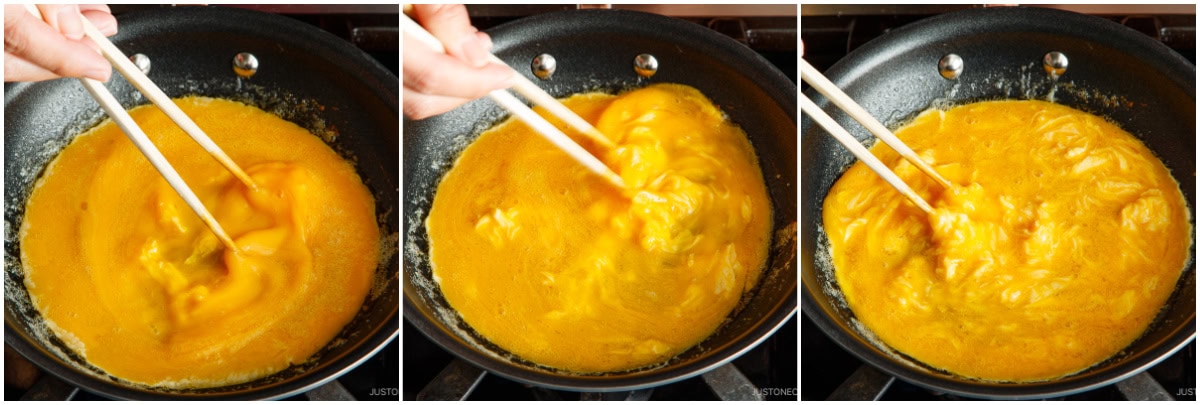
- Stop stirring when the eggs are half-cooked. You want to see a smooth omelette surface, not the chopsticks’ stirring marks, so stop stirring while the eggs are rather runny. Tilt the frying pan to spread out the uncooked egg mixture. The egg curds should look creamy, soft-scrambled, and custardy at this stage. You don‘t want to overcook them, as they’ll continue to cook a little with the residual heat. Make sure to level the egg curds.
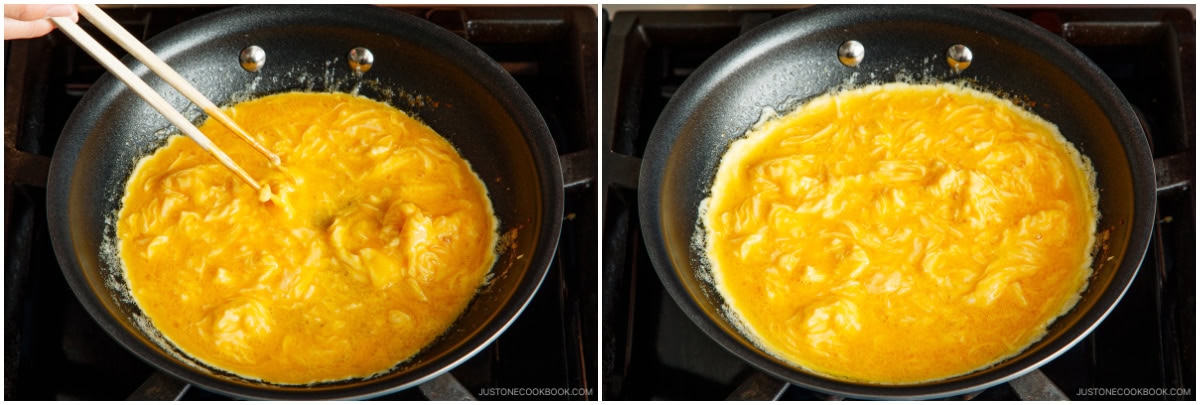
- Place 1 portion of chicken rice in the center of the omelette. Spread it out to the sides a little. Create a rough football shape without moving and touching the omelette. Turn off the stove‘s heat.
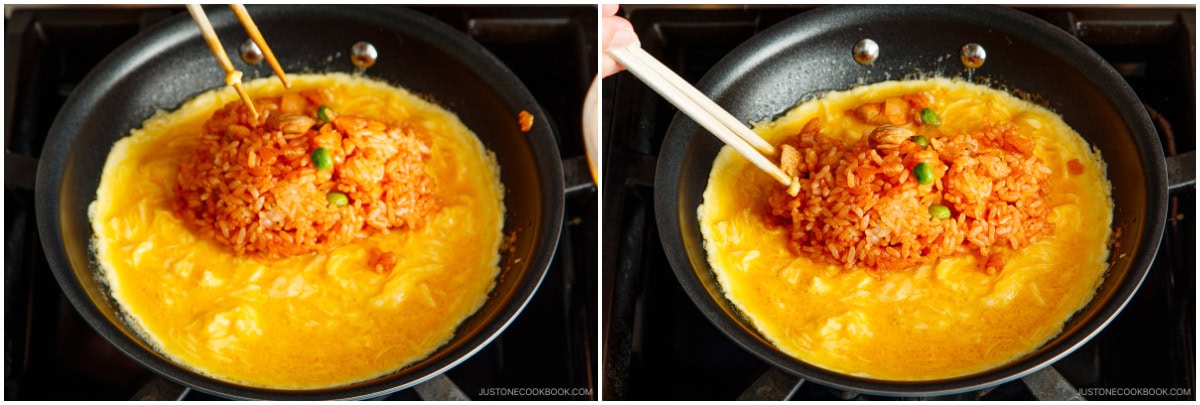
- Move the pan to a wet folded cloth to cool it. This keeps the omelette from browning so that your omurice is an even pale yellow color. Then, slide the omelette to the far edge of the pan. Wrap the rice with the omelette from both sides.
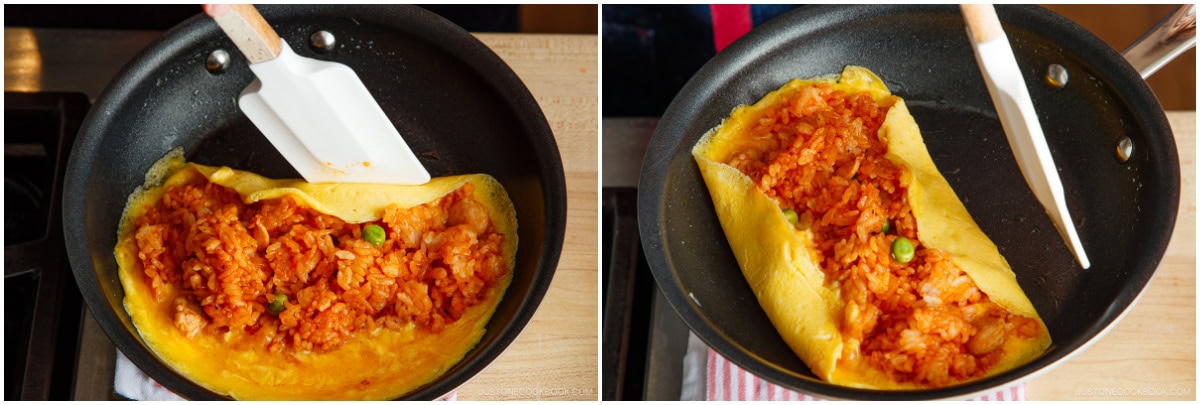
- Hold a plate in one hand and the pan in the other and tilt the plate next to the omurice. Then, flip the frying pan upside down at an angle to transfer the omurice, seam side down, onto the plate.
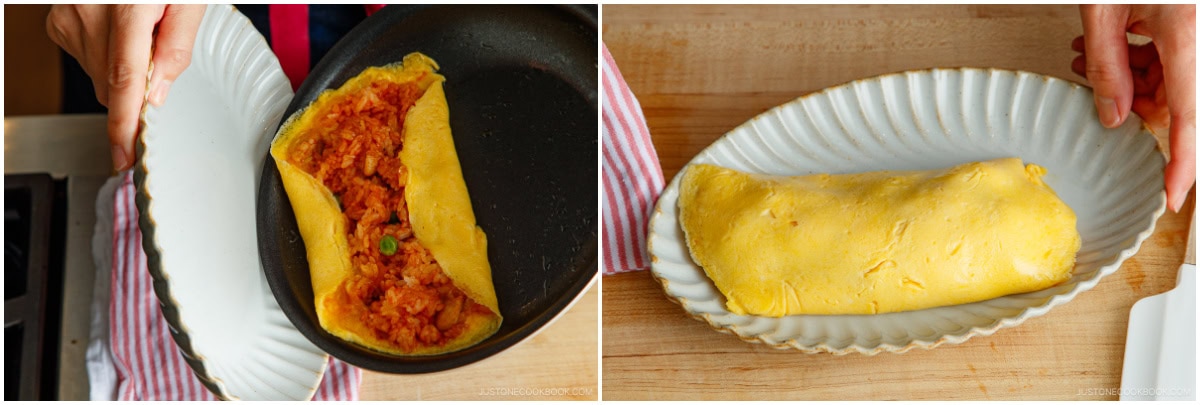
To Serve
- Place a paper towel on top of the omurice and gently mold it with your hands into the shape of a football or rugby ball. Drizzle additional ketchup on top or in a zigzag pattern. Enjoy!
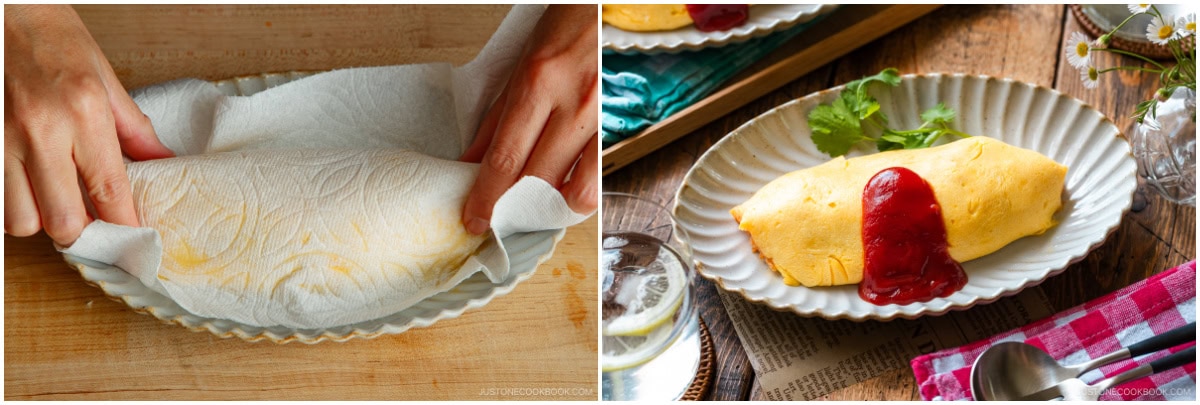
To Store
- You can keep the leftovers in an airtight container and store in the refrigerator for up to 3 days or in the freezer for a month.
Equipment
Nutrition
Editor’s Note: This post was originally published on August 14, 2012. It was updated with a revised recipe, more helpful content, and new images on May 7, 2024. A new video was added on November 15, 2024.
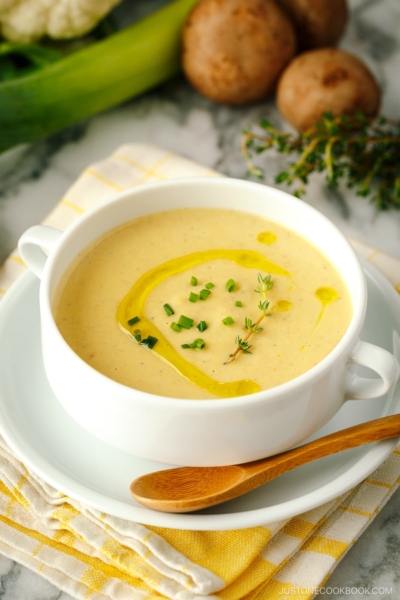
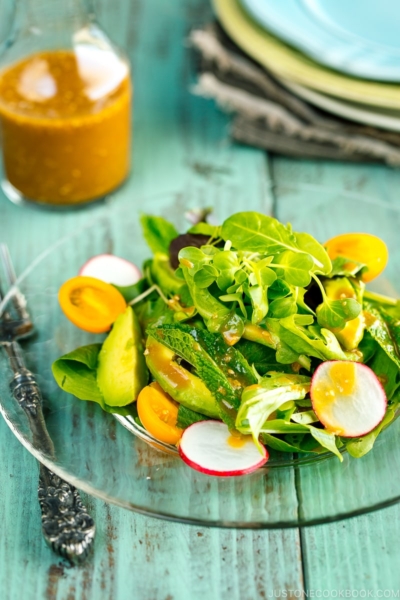
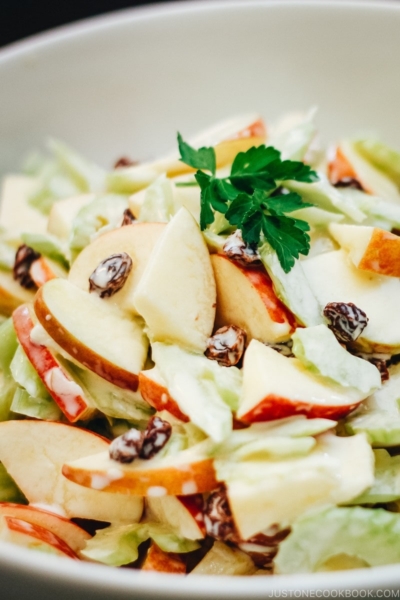
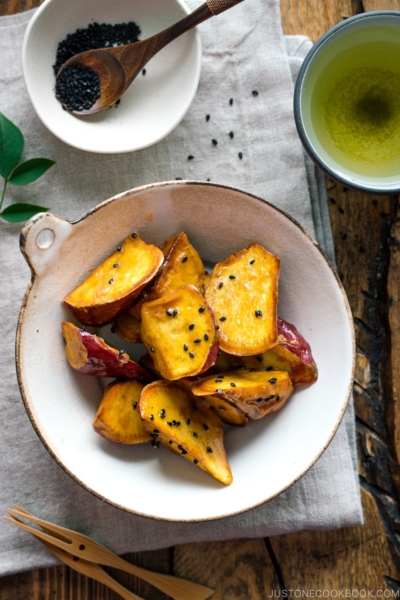




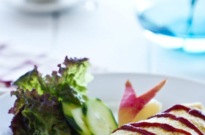
I eouod like to sign up for your news letter, but the site would not let me. Please let me know how to proceed.
Thank you!
Hi Ann! I manually added to you to my list. Thank you for subscribing to my newsletter! 🙂
Just discover your website when I was curious and googled about omurice.
You have created such a friendly and helpful site in Japanese cooking ????
Impressed with the thoughtful pictorial step by step guidance.
Also discover your videos – Fantastic!
Thank you
Hi San! I’m so happy to hear you found my site on Google search! Welcome to my blog/youtube channel. Hope you enjoy my recipes.
Great recipe. And if you are single like me, you can store the extra rice mix in tupperware and just nuke a portion on a plate to make more the following days. I got a dinner and three breakfasts from just one batch.
Hi Bob! Thank you for sharing your tip too! Thanks for trying this recipe and for your kind feedback. 🙂
Namiちゃん!
I saw you this morning on the paper OnSunday, what a surprise! Congratulations!
And once more thank you very much indeed to you and all your staff for this home page that saves my dinner here in Japan for the happiness of the kids.
今日もはなまるでした(^∇^)
Thank you for finding me on the newspaper! It’s so cool you live in Japan and got to read the newspaper. 🙂 Thank you very much for your kind words.
Hmmm I’ll have to try this out! I was always wary of the ketchup thing but when my host family when I was in Japan cornered me with a plate I had to try it and was very surprised at how good it was! I’ve been looking for a recipe to try ever since.
Hi Maria! Haha, it’s interesting how Japanese adapted American ketchup into our cooking. 🙂 Hope you enjoy this recipe. Thank you!
Yes, Omu is close to English Home
So when I was told Omurice I understood Homerice, thank you, I’m a fan, will be following you for ever. I loved ( enjoyed) my experience in Nippon, in 1974-75. Lived in Shinkoiwa, worked in Asakusabashi and trained in karate Shytoriu in Kiowa. Thank you and continue your good work.
Hi Alain! Thank you so much for following me! I’m happy to hear you have good memories of Japan. 🙂
This has to be one of my top favorite things to make, and eat! Though I do cook the filling in my rice cooker instead on the stove. I have to say, I love the infused taste the rice ends up getting compared to a pan. But still, a fantastic dish hands down!
Hi Audrey! Ohh that’s a good way to save time too! 🙂
Thank you for this. My children have recently started studying Japanese at school and this receipe caught their attention. Seeings as my son is Autistic and hardly eats anything when he asks for something I look for it. I was worried it was going to be hard but your directions were easy to follow and simple to understand. Again thank you very much!
Hi Chantel! You’re welcome. Your children is studying Japanese! Awesome! I’m so happy you tried this recipe and it came out well. Thank you for your kind feedback! 🙂
I want to know more recipes and cook for my husband and in-laws…
Hope you subscribe to my blog and youtube channel. 🙂
Thank you for the recipe and the easy to follow step by step guide 😀 My boyfriend got curious about this dish via anime, so I promised to try and cook it for him.
I think I should have used a smaller frying pan however as the egg seemed to spread a bit too thin and kept breaking, but I did manage something semi-decent looking anyway 😀 I guess it turned out okay for the first time. I’ll try it with a smaller pan next time… or perhaps it wasn’t the pan, but I just need more practice with it 😀
HI Annika! I’m happy to hear you tried this recipe! You can use a smaller pan but you can’t put too much rice either. Hope you find a good balance. Thanks for trying this recipe and for your feedback! 🙂
Would this still work/taste good without the use of ketchup?
Hi Squishy! If ketchup is not your favorite, you can use tomato sauce or soy sauce. 🙂
It looks really delicious, definately gonna try it.
My mom hates soy sauce so would it alright if I were to leave it out or would that totally ruin it?
Hi Ashley! Sure, that’s okay. 🙂 Hope you and your mom enjoy this recipe! 🙂
Its really help me a lot …
Thanks ^^
Thank you for reading Vita! 🙂
Hi Nami
What goes good to drink with Omurice usually? Thanks!
Hi Srita! Hmmm that’s a hard question!!! If it’s lunch time I serve it with Mugicha (Barley tea)… We don’t drink soda or juice much in my house. 🙂
Is it fine to let the egg still half cooked? or was it to make the rice stick on the egg?
Hi Tania! It’s more about personal preference. A lot of people prefer half cooked, not because it “sticks” to the rice, but people prefer runny egg + rice combination. It’s softer, fluffier, and creamier… but if you don’t like half cooked egg and want to cook it completely, that’s okay too! My children prefer completely cooked so I often do that. You can still make good omelette. 🙂